Abstract
The contamination of water bodies by industrial dyes poses a significant environmental challenge on a global scale. Conventional wastewater treatment methods often suffer from limitations related to high cost, limited efficiency, and potential secondary environmental impacts. Recent advances in photocatalytic technologies have highlighted the potential of metal sulfide-based photocatalysts, particularly those synthesized through environmentally friendly, plant-mediated approaches, as promising alternatives for efficient and sustainable dye degradation. However, despite their promising potential, metal sulfide photocatalysts often suffer from limitations such as photocorrosion, low stability under irradiation, and rapid recombination of charge carriers, which restrict their long-term applicability. In light of these challenges, this review provides a comprehensive examination of the physicochemical characteristics, synthetic strategies, and photocatalytic applications of metal sulfides. Particular emphasis is placed on green synthesis routes employing plant-derived extracts, which offer environmentally benign and sustainable alternatives to conventional methods. Moreover, the review elucidates various modification approaches, most notably, the formation of heterostructures, as viable strategies to enhance photocatalytic efficiency and mitigate the aforementioned drawbacks. The green synthesis of metal sulfides, aligned with the principles of green chemistry, offers a promising route toward the development of sustainable and environmentally friendly water treatment technologies.
1. Introduction
Water is an essential resource for sustaining life and maintaining ecological balance. However, contamination of water by hazardous substances has emerged as a critical global challenge [1]. Factors contributing to this issue include rapid industrialization, unregulated urban expansion, irresponsible exploitation of natural water resources, and significant population growth [2]. Water pollution is further exacerbated by the direct discharge of industrial and municipal waste into aquatic ecosystems [3]. In particular, the release of untreated or poorly treated industrial effluents contributes heavily to this problem. It is estimated that approximately 10% of the 7 × 105 tons of dyes produced globally each year are discharged into the environment, resulting in substantial organic pollution that threatens both human and aquatic life [4]. Synthetic dyes are among the most prevalent and persistent pollutants, and are commonly used in industries such as pharmaceuticals, textiles, food processing, paper manufacturing, and cosmetics [5]. Dyes such as methylene blue (MB), rhodamine B (RhB), methyl orange (MO), Congo red (CR), Disperse Violet 26 (DV), Methyl Red (MR), and Crystal Violet (CV) are particularly notorious for contributing to industrial water pollution across various sectors [6]. Addressing this issue is crucial, as even trace amounts of these dyes (less than 1 ppm) can impart intense coloration to water bodies, alter transparency, and reduce gas solubility [7,8]. These changes disrupt aquatic ecosystems by hindering light penetration, thereby inhibiting photosynthesis and causing oxygen depletion, which ultimately threatens biodiversity and aquatic health [9,10,11].
Over the past three decades, a wide range of biological, chemical, and physical processes have been extensively explored for wastewater treatment, particularly for the removal of synthetic dyes and pharmaceutical contaminants (Table 1) [12]. These conventional methods include precipitation, ion exchange, solvent extraction, electrochemical treatments, biodegradation, and phytoremediation. Although these approaches have demonstrated varying degrees of success, they have significant limitations when applied to the treatment of complex and persistent pollutants, such as synthetic dyes and emerging pharmaceutical residues. The key challenges include high operational costs, the generation of sludge, membrane fouling, low degradation efficiency for recalcitrant compounds, and the production of secondary waste, all of which hinder practical large-scale implementation [13]. For instance, while coagulation and flocculation are cost-effective, they often result in substantial secondary waste [14]. Adsorption techniques, although efficient, require frequent regeneration of the adsorbent material, limiting their long-term viability [15]. Electrocoagulation, despite its effectiveness in metal recovery, involves high equipment costs, making it less accessible for widespread use [16]. Similarly, membrane filtration technologies and trickling filters, though free from chemical additives, are prone to rapid membrane fouling and clogging respectively, reducing their operational lifespan [17,18]. Even advanced oxidation processes (AOPs), which are promising for the degradation of resistant organic pollutants, remain largely confined to laboratory-scale studies due to their cost-intensive nature and operational complexities [19].
Given these limitations, there has been a transition towards more sustainable and efficient alternatives such as heterogeneous photocatalysis, which offers the potential for complete mineralization of organic pollutants under mild conditions, often using solar or visible light as the energy source [20,21,22,23].

Table 1.
Previously studied water treatment processes.
Table 1.
Previously studied water treatment processes.
| Treatment Method | Advantage(s) | Limitation(s) | Ref. and Year |
|---|---|---|---|
Coagulation/flocculation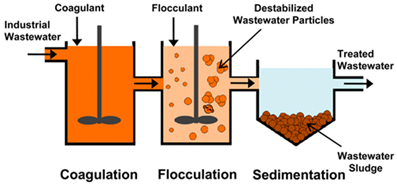 | Inexpensive | Produces secondary waste | [14], 2005 |
Adsorption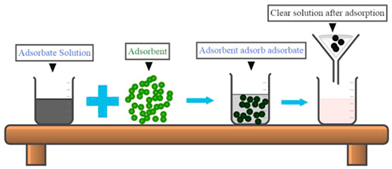 | Effective for organic contaminants, easy to implement | Adsorbent incurs frequent replacement or regeneration costs | [15], 2021 |
Trickling Filters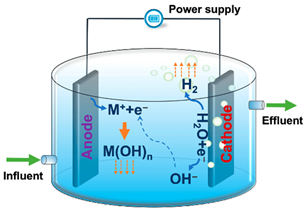 | Effective technology for recovering and recycling precious metals | Costly equipment | [16], 2021 |
Electrocoagulation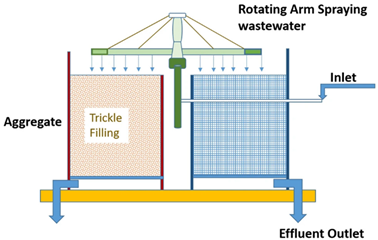 | Low energy consumption, simple operation | Requires large area, can become clogged, less effective for high-strength waste | [17], 2022 |
Membrane technology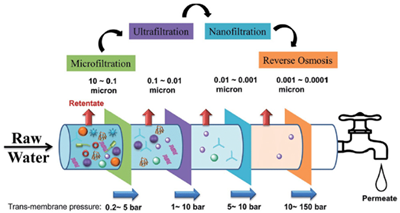 | Requires no chemicals | Rapid membrane fouling | [18], 2010 |
Advanced oxidation processes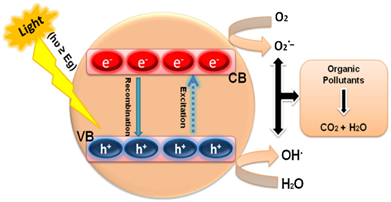 | Highly effective for recalcitrant organic pollutants, no sludge formation, can remove emerging contaminants | Laboratory scale | [19], 2012 |
Advanced oxidation processes (AOPs) have emerged as a promising chemical technology for the remediation of environmental pollutants, and have gained substantial attention over the past few decades. These techniques are particularly effective for the oxidation, degradation, and complete mineralization of organic contaminants [24]. AOPs function by generating highly reactive oxygen species (ROS) in situ, including hydroxyl radicals (•OH), hydrogen peroxide (H2O2), ozone (O3), and superoxide anion radicals (O2−). These reactive species exhibit low selectivity and strong oxidative potential, enabling the conversion of complex organic pollutants into harmless end-products such as carbon dioxide (CO2), water (H2O), and inorganic ions or acids [25].
Among AOP techniques, photocatalysis represents a particularly promising pathway due to its ability to harness light energy to activate semiconductor materials (Figure 1). In this process, a series of redox reactions take place on the surface of the photocatalyst, driven by the material’s unique bandgap energy (E9), which is the energy difference between the valence band, where electrons are normally localized, and the conduction band, where electrons are free to move [26]. When the photocatalyst is exposed to light with an energy equal to or greater than its bandgap, electrons in the valence band are excited to the conduction band within femtoseconds (10−15 s), leaving behind positively charged holes (h+). This excitation creates electron–hole pairs, which are highly reactive and initiate oxidative and reductive reactions at the catalyst surface.
The subsequent separation of these electron–hole pairs is critical for efficient photocatalysis. If recombination is suppressed, the trapped electrons and holes participate in a cascade of surface reactions, leading to the formation of hydroxyl radicals (OH) and other reactive species. These radicals oxidize organic contaminants, breaking them down into intermediate products, which are further degraded through successive reactions to yield carbon dioxide and water as final by-products [27]. This mechanism underscores the potential of photocatalysis as a sustainable approach for the degradation of persistent organic pollutants.
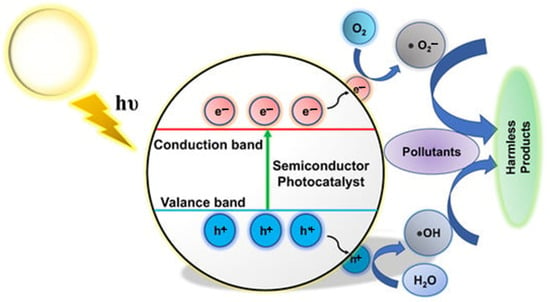
Figure 1.
Schematic illustration of the photocatalytic degradation process using a semiconductor photocatalyst. The glowing circle represents the light source, which provides the energy required to activate the photocatalyst. The yellow arrow indicates the direction of light irradiation toward the photocatalyst surface, initiating the photocatalytic degradation of dye molecules in the solution. The black arrows depict the migration of photogenerated electrons (e−) from the conduction band and holes (h+) from the valence band, which participate in redox reactions. The blue arrows illustrate the charge carrier pathways facilitating photocatalytic degradation, where electrons and holes drive the formation of reactive species for efficient pollutant mineralization. Reprinted from Ref. [28].
Heterogeneous photocatalysis has been widely employed to degrade a variety of refractory organic pollutants, converting them into more biodegradable compounds using semiconductors such as zinc sulfide (ZnS), titanium dioxide (TiO2), gallium phosphide (GaP), ferric oxide (Fe2O3), cadmium sulfide (CdS), and zinc oxide (ZnO) [29]. The success of this process largely depends on selecting an appropriate photocatalyst that can efficiently initiate and sustain the photodegradation reactions.
An ideal photocatalyst should possess several critical properties. It must be capable of absorbing a broad spectrum of sunlight, efficiently generating electron (e−)–hole (h+) pairs, and promoting surface reactions that degrade pollutants while retaining photocatalytic stability and reusability over multiple cycles [30]. These materials are typically activated by ultraviolet (UV), visible, or near-infrared (NIR) radiation, which excites electrons from the valence band to the conduction band, leaving behind holes that participate in subsequent redox reactions [31].
Despite their potential, nano-metal oxide photocatalysts face several limitations. These include poor light absorption in the visible spectrum, high production costs, rapid recombination of electron–hole pairs, limited structural stability, and sluggish surface reaction kinetics. Collectively, these drawbacks hinder the overall photocatalytic efficiency and restrict the practical application of conventional nano-metal oxides in large-scale environmental remediation [32].
Metal sulfides (MSs) have recently emerged as promising candidates for photocatalytic water treatment applications. Compared to conventional metal oxide photocatalysts such as TiO2 and ZnO, which possess wide bandgaps (∼3.2 eV and ∼3.3 eV, respectively) and are thus primarily active under UV irradiation, metal sulfides exhibit narrower bandgaps (typically <3.0 eV), enabling visible light absorption and enhanced solar spectrum utilization [33,34]. This is attributed to the presence of sulfur anions, which introduce intermediate energy states and shift the absorption edge into the visible region, extending up to approximately 520 nm. Moreover, sulfur atoms possess higher electron affinity and lower ionization potential compared to oxygen, which facilitates more efficient electron excitation and transport, thereby reducing electron–hole recombination rates and improving overall photocatalytic activity [35]. Additionally, metal sulfides often possess a high density of surface-active sites and favorable electronic structures, further contributing to their photocatalytic performance [36]. These advantages underscore the potential of MS-based photocatalysts as viable alternatives to traditional metal oxides in visible-light-driven wastewater remediation. Although metal sulfides (MSs) offer several advantages over conventional metal oxides (MOs), they are not without limitations. Issues such as nanoparticle aggregation, potential toxicity, and environmental risks associated with their synthesis and application have raised concerns regarding their safe use in water treatment processes [37]. In particular, the possibility of introducing secondary pollutants into aquatic systems has prompted researchers to explore more sustainable and eco-friendly approaches. As a result, there has been a growing shift toward the green synthesis of metal sulfides, utilizing plant-derived extracts and natural reducing agents to minimize the environmental impact.
In light of these developments, this review provides a critical and comprehensive analysis of metal sulfide-based photocatalysts, with a particular focus on their green synthesis using plant extracts. The review also discusses their application in the degradation of organic dyes and pharmaceutical contaminants, highlighting both their potential benefits and current limitations in environmental remediation. In contrast to previous reviews that primarily focused on either photocatalytic mechanisms or conventional synthetic routes, this work offers an integrated perspective that highlights recent advances in eco-friendly synthesis approaches and their implications for photocatalytic efficiency. The review further addresses the inherent limitations of metal sulfides and evaluates the role of heterostructure engineering as a strategy to overcome these challenges. By bridging the domains of green chemistry and material design, this review provides novel insights into the sustainable development of metal sulfide photocatalysts, offering future directions for enhanced environmental remediation technologies.
2. Properties of Metal Sulfide Photocatalysts
Metal sulfides (MSs) are inorganic compounds composed of sulfur and one or more metal elements (Figure 2) [38]. Based on their elemental composition, MSs are classified into binary metal sulfides (e.g., AgS and CuS), ternary metal sulfides (e.g., ZnIn2S4 and CuInS2), and quaternary metal sulfides (e.g., Cu2ZnSnS4) [39].
Structurally, metal sulfides exhibit complex electronic interactions due to the presence of localized or itinerant 3d electrons from the sulfur atoms. These electrons can hybridize with the 3s and 3p orbitals of sulfide, stabilizing adjacent metal cations through various anionic coordination geometries, including trigonal, octahedral, and tetrahedral arrangements. This hybridization facilitates the formation of covalent metal–metal (M–M) and sulfur–sulfur (S–S) bonds, contributing to the structural integrity and stability of these compounds. In layered metal sulfide structures, enhanced polarization and covalent interactions also promote the formation of Van der Waals forces between layers, influencing material properties such as flexibility and electronic conductivity. Generally, the structural characteristics of MSs are determined by factors such as ionic size, charge distribution, and electron configuration, leading to closely packed arrangements that define their crystallographic and functional behaviors [40].
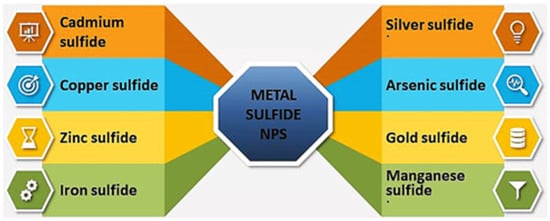
Figure 2.
Metal sulfide nanoparticles Adapted with permission from Ref. [38] Copyright 2022 Elsevier.
Most metal sulfide photocatalysts belong to the class of typical II–VI semiconductors, which are characterized by their narrow bandgap energies. This feature imparts excellent optical properties and high quantum efficiency when these materials are exposed to visible light, making them highly attractive for photocatalytic applications [41,42]. The development of efficient photocatalysts relies heavily on a detailed understanding of the fundamental physicochemical properties of metal sulfide semiconductors.
Metal sulfides are generally crystalline solids that exhibit a diverse range of colors, including black, brown, yellow, and metallic shades. Many display high melting points and are insoluble in water, although some may dissolve in acidic or alkaline media. Certain metal sulfides, such as pyrite (FeS2), possess a metallic luster, whereas others, like zinc sulfide (ZnS), appear dull or translucent depending on their crystalline form.
The crystal structure of metal sulfides varies depending on the specific metal involved and the stoichiometry of the compound (Figure 3). Among the most common structural types are the sphalerite and wurtzite forms, both exemplified by zinc sulfide (ZnS). The sphalerite structure is a cubic close-packed lattice, where metal ions occupy half of the tetrahedral voids within the sulfide framework. This arrangement is typical of ZnS in its low-temperature phase and is widely utilized in phosphorescent materials and optoelectronic devices due to its semiconducting properties. In contrast, the wurtzite structure represents a hexagonal modification of ZnS, where metal ions also occupy tetrahedral sites but in a different spatial configuration. The wurtzite phase is less dense than sphalerite and is commonly observed in high-temperature forms of ZnS and other metal sulfides. Understanding these structural variations and their associated electronic properties is crucial for optimizing the photocatalytic activity of metal sulfides, particularly in applications related to environmental remediation and pollutant degradation.
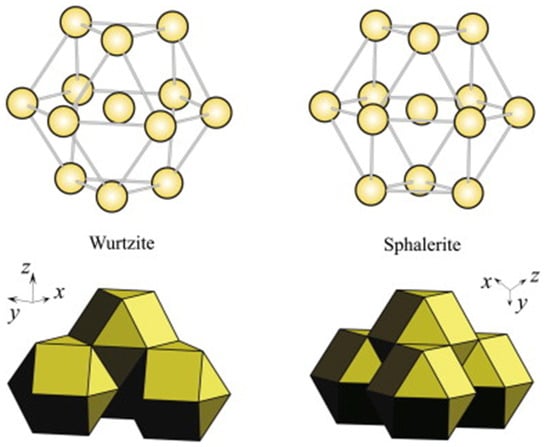
Figure 3.
The sequence of the fragments in the cases of sphalerite and wurtzite (cation atoms eliminated) and the second coordination sphere for sulfur atoms. Adapted with permission from Ref [43] Copyright 2013 Elsevier.
Metal sulfides exhibit diverse chemical reactivities and physical properties that depend on the specific metal component and compound structure. While many metal sulfides are stable in air, some, such as iron sulfide (FeS), are prone to oxidation upon exposure to moisture, leading to the formation of sulfates. Additionally, metal sulfides often react with strong acids, releasing hydrogen sulfide (H2S), a toxic gas with a characteristic rotten egg odor. Certain metal sulfides, such as copper sulfide (CuS), are chemically stable and resistant to corrosion, making them valuable for applications in anti-corrosion coatings and industrial materials [44].
Several metal sulfides also exhibit important semiconducting and optoelectronic properties. For example, lead sulfide (PbS) and molybdenum disulfide (MoS2) function as semiconductors and are widely used in electronics, sensors, and photovoltaic devices. Zinc sulfide (ZnS) is notable for its phosphorescent and luminescent properties, making it suitable for display technologies and optical instruments. Structurally, metal sulfides adopt various crystalline forms. The pyrite-type structure (FeS2-type) consists of iron cations and sulfur dimers arranged in a dense cubic configuration. Pyrite (FeS2), commonly referred to as “fool’s gold,” exemplifies this stable structure, which is resistant to oxidation under normal environmental conditions. The galena-type structure (PbS-type) resembles the sodium chloride (NaCl) lattice, with lead and sulfur ions arranged in a face-centered cubic (FCC) pattern. This structure is typical of lead sulfide (PbS) and is also observed in related compounds such as silver sulfide (Ag2S).
Furthermore, certain metal sulfides form layered structures, as seen in molybdenum disulfide (MoS2) and tungsten disulfide (WS2). These materials have weak van der Waals interactions between layers, allowing them to easily slide over one another. This characteristic imparts excellent lubricating properties, making them suitable for solid lubricants and friction-reducing coatings.
Metal sulfide photocatalysts possess unique structural, optical, and electronic properties that render them highly effective for a wide range of applications, particularly in semiconductor technology and photocatalysis. Their classification into binary, ternary, and quaternary sulfides reflects the diversity in their elemental composition, which directly influences their physical and chemical behaviors. The presence of hybridized orbitals, covalent bonding interactions, and variable crystal structures—including sphalerite, wurtzite, pyrite, and layered configurations—further contributes to their stability, versatility, and functional performance. These structural and electronic features are fundamental in enhancing photocatalytic efficiency, as they affect parameters such as light absorption, charge carrier dynamics, and surface reactivity. A comprehensive understanding of these properties is therefore critical for the rational design and development of advanced sulfide-based metal applications, particularly for applications in energy conversion, environmental remediation, and next-generation electronic devices.
3. Synthesis of Metal Sulfides
Metal sulfide nanostructures can be synthesized through two principal approaches: top-down and bottom-up methodologies. The top-down approach, which includes techniques such as lithography, ball milling, sputtering, and electrospinning, involves breaking down bulk materials into nanoscale structures [45]. While top-down methods are well-established, they suffer from several limitations, including high costs, structural defects, particle size inhomogeneity, and contamination risks [46]. These drawbacks often compromise the surface uniformity and crystallinity of the resulting nanoparticles, factors that are critical for efficient photocatalytic performance, as defects can serve as electron–hole recombination centers, reducing photocatalytic efficiency [47].
In contrast, bottom-up approaches synthesize nanostructures atom by atom, offering better control over the morphology, crystallinity, and surface area. Common bottom-up techniques (Figure 4) include precipitation, atomic layer deposition, chemical vapor deposition (CVD), hydrothermal and solvothermal synthesis, and microwave-assisted methods [48]. Among these, hydrothermal and solvothermal methods are frequently employed for photocatalyst synthesis due to their ability to produce materials with high crystallinity, tunable shapes, and narrow particle size distributions [49]. Control over these parameters is vital since smaller particle sizes increase the surface area and number of active sites, while controlled crystal growth reduces defects, enhancing photocatalytic degradation of dyes [50].
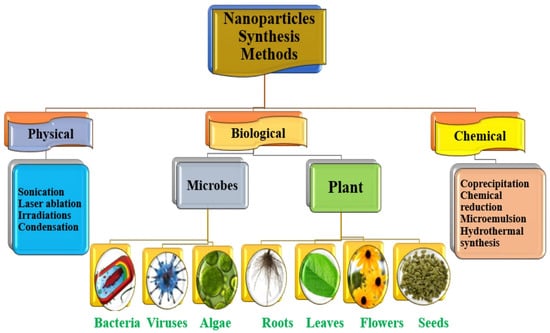
Figure 4.
Methods for synthesis of nanoparticles. Reprinted from Ref. [51].
The dimensionality of the synthesized nanostructures including zero dimensions, one dimension, two dimensions, or three dimensions has a direct impact on photocatalytic performance. For instance, 0D ZnS quantum dots (Figure 5) were synthesized via co-precipitation by Mansour et al. and found to exhibit high surface-to-volume ratios and quantum confinement effects, which enhance light absorption and provide abundant active sites for photocatalytic reactions [52,53]. Furthermore, the sample had a spherical morphology with a particle size of 9 nm. However, quantum dots may suffer from aggregation, which reduces their effective surface area.
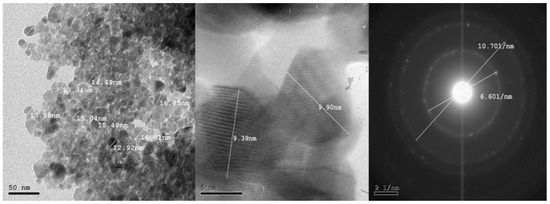
Figure 5.
HRTEM of ZnSQDs. Adapted with permission from Ref [52] Copyright 2021 Springer Nature.
One-dimensional (1D) nanostructures, such as wires, rods, belts, and tubes, have received significant attention due to their applications in mesoscopic physics and nanoscale devices [54]. Importantly, 1D nanostructures provide an excellent model for studying the effects of size confinement on electron transport, thermal conductivity, and surface reactivity, which are factors that are directly linked to photocatalytic activity. Transition-metal sulfides synthesized in 1D forms typically exhibit enhanced electron transfer pathways and reduced recombination of charge carriers, thus improving degradation rates during photocatalysis.
Various synthesis techniques have been developed for the synthesis of 1D transition-metal sulfide nanostructures. For instance, a single-crystal CdS nanowire array was synthesized on porous alumina using a template-controlled method [55]. Similarly, nanotubes were obtained through the pyrolysis of artificial lamellar mesostructures composed of soft organic surfactants [56]. Additionally, the solvothermal method has been used to successfully synthesize a variety of sulfide nanowires, rods, and tubes, demonstrating its versatility.
Ge et al. [57] utilized the chemical vapor deposition (CVD) technique to synthesize 1D nanostructures of various metal sulfides (Figure 6). Their study revealed that CdS, ZnS, CoS, NiS, MnS, and Fe7S8 formed high-aspect-ratio nanowires, while Cr2S3 and WS2 predominantly produced rods and tubes. For CuxS, the synthesized nanoparticles were about 100 nm in size, though some long whisker-like structures also formed. These morphological variations influence photocatalytic properties by modulating the surface exposure and light absorption capacities of the nanostructures.
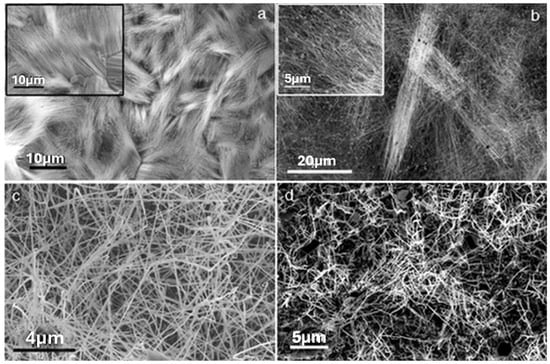
Figure 6.
SEM images of produced (a) CdS, (b) CoS, (c) MnS, and (d) Fe7S8 nanowires ] (LO). Insets in (a) and (b) show higher-magnification views of the nanowire structures to provide greater detail on morphology and alignment. The scale bars are 10 µm for both the main image and inset in (a), and 20 µm (main) and 5 µm (inset) in (b). Adapted with permission from Ref [57] Copyright 2004 John Wiley and Sons.
Gorai et al. [58] reported the synthesis of crystalline copper sulfide (Cu2S) with varied morphologies including microspheres, nanorods, and nanowires using a surfactant-assisted method. The optical band gap, measured using reflectance spectra, ranged from 1.22 to 1.24 eV, indicating potential for visible light photocatalysis. Similarly, Bhardwaj et al. [59] synthesized NiS nanoparticles via the hydrothermal method, producing both 3D nanospheres and 1D nanorods. The mean crystallite sizes were reported as 33.56 nm, 35.26 nm, and 39.56 nm, reflecting the impact of the synthesis conditions on the particle morphology and size distribution.
Two-dimensional (2D) nanomaterials have also emerged as promising candidates for photocatalytic and environmental applications due to their unique electronic, magnetic, and surface properties [60,61,62]. These include transition metal dichalcogenides (TMDs) [63], graphene [64], and black phosphorus [65]. The general formula for TMDs is MX2, where M represents a transition metal and X denotes S, Se, or Te. The sandwich structure, comprising two X layers surrounding an M layer, enhances surface reactivity and active site exposure, improving photocatalytic processes such as dye degradation [66,67,68].
However, the synthesis of phase-controlled 2D iron sulfides remains challenging due to their non-layered structure and compositional sensitivity. The CVD process has enabled the fabrication of high-quality 2D materials with large domain sizes and precise phase control, though it has been rarely applied to FeS systems. Wang et al. [69] employed a molecular sieve-assisted CVD technique to synthesize 2D FeS nanoflakes, successfully obtaining non-stoichiometric Fe7S8 nanoflakes, tetragonal FeS stacks, and ultra-thin hexagonal FeS structures by adjusting the Fe/S ratio and growth temperatures. These morphological variants exhibit different photocatalytic potentials due to their altered surface chemistry and defect density. Moreover, pyrolysis was used to obtain 2D magnetic nanosheets of pyrrhotite (Fe7S8) and greigite (Fe3S4), where higher temperatures promoted the transformation of cubic Fe3S4 to hexagonal Fe7S8 and FeS. The final structures exhibited lateral dimensions between 100 and 800 nm, depending on the phase and processing conditions [70] (Figure 7).
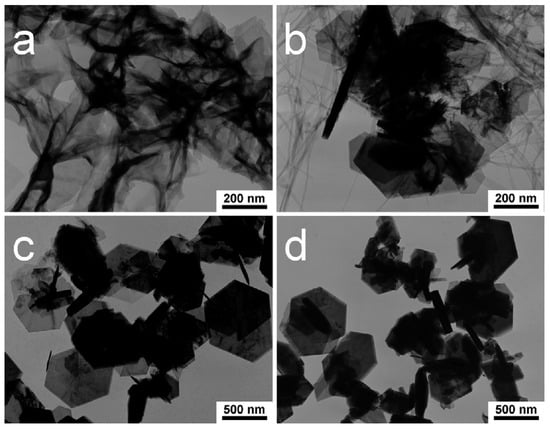
Figure 7.
2D nanosheets of (a) pyrrhotite (Fe7S8), (b) greigite (Fe3S4), (c) cubic Fe3S4 and (d) hexagonal Fe7S8 and FeS nanoflakes. Adapted with permission from Ref [70] Copyright 2008 American Chemical Society.
Nickel sulfide (NiS) nanosheets were synthesized by Naveed et al. [71] using a mesoporous approach, achieving a large surface area of 210 m2/g, which is advantageous for photocatalytic degradation due to the increased number of active sites. Jothi et al. [72] developed nanoporous crystalline NiS through a soft-templating method, where different hydrothermal temperatures yielded various phases and flake-like morphologies with lateral dimensions of 80–100 nm. Additionally, growth substrates placed downstream in a CVD furnace generated 2D copper sulfide (CuS) nanoflakes with hexagonal structures, which measured approximately 20 nm in thickness and 500 nm in edge length [73]. These hierarchical assemblies improve light scattering and adsorption, enhancing photocatalytic efficiency.
In the case of three-dimensional (3D) nanostructures, BaS3:La2S3:PrS1.7 nanocomposites were synthesized using a single-source precursor method, yielding particles with mixed morphologies such as nanorods, spheres, and rectangular forms. The average crystallite size was reported as 17.39 nm, and the band gap was found to be 3.6 eV [74]. Similarly, Nouseen et al. [75] synthesized ternary metal sulfide microspheres (CuCo2S4, CuMn2S4, CuZn2S4, and CuNi2S4) for water-splitting applications using a one-pot synthesis. These materials exhibited cubic thiospinel and mixed phases, highlighting the tunability of morphology in ternary systems (Figure 8).
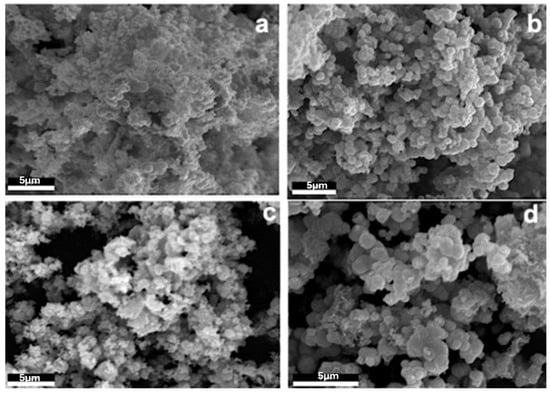
Figure 8.
SEM images of ternary metal sulfide based on transition metals: (a) CuCo2S4, (b) CuMn2S4, (c) CuNi2S4, and (d) CuZn2S4 microspheres Adapted with permission from Ref [75] Copyright 2022 Elsevier.
Despite the diversity of synthetic approaches, each method presents specific limitations that directly impact on the photocatalytic efficiency of the resulting metal sulfides. For instance, the hydrothermal method often requires prolonged reaction times, and the non-uniform heat distribution can result in heterogeneous particle sizes. This variability leads to inconsistent active surface areas and non-uniform light absorption, ultimately reducing the reproducibility and efficiency of photocatalytic degradation. In contrast, microwave-assisted synthesis enables faster reaction kinetics and typically yields high-purity products; however, issues such as nanoparticle aggregation and poor long-term stability can occur. These problems hinder the effective separation of charge carriers and increase the likelihood of electron–hole recombination, thereby lowering photocatalytic performance. Chemical vapor deposition (CVD) provides excellent control over morphology and crystallinity but operates at high temperatures and involves complex, multi-step processes. These conditions may introduce defects or residual stresses in the material, potentially altering the band structure and affecting the charge transfer dynamics critical for photocatalysis. Additionally, during the synthesis of metal sulfides, particle agglomeration in aqueous media frequently occurs, reducing the overall surface area and diminishing the number of accessible active sites. This agglomeration directly impairs catalytic performance by limiting pollutant adsorption and light-driven reaction efficiency [76].
Due to these constraints, there has been an increasing shift towards green synthesis techniques, which employ plant extracts, bacteria, or fungi as reducing and capping agents. These methods minimize toxic by-products and often yield nanostructures with enhanced surface functionalities that can further promote photocatalytic dye degradation.
4. Green Synthesis of Metal Sulfides
Over the past decade, green chemistry approaches have gained momentum in the synthesis of metal sulfide nanoparticles, emphasizing the use of non-toxic solvents, plant extracts, and biological systems [47]. These methods are considered cost-effective, environmentally friendly, and capable of producing nanomaterials with desirable properties for catalytic, biomedical, and environmental applications. In addition to reducing the environmental risks associated with traditional chemical methods, green synthesis can tailor the physicochemical properties of nanoparticles such as size, shape, crystallinity, and surface chemistry, which directly affect their photocatalytic performance in dye degradation.
Biological agents, including bacteria and fungi, play an essential role in green nanoparticle synthesis. For example, certain bacteria enzymatically reduce sulfate ions to sulfide ions, facilitating metal sulfide nanoparticle formation [50]. Fungi are particularly effective because they produce stable nanoparticles with enhanced bioactivity and reduced aggregation tendencies [53]. This is advantageous for dye degradation applications, as nanoparticle stability improves reusability and reduces photocatalyst deactivation. Fungi also generate nanoparticles with smaller sizes and better dispersibility due to their abundant bioactive metabolites, enhancing surface reactivity and charge transfer during photocatalytic processes [77].
Plant-mediated synthesis offers additional benefits. Plants are rich in phytochemicals such as flavonoids, terpenoids, polyphenols, and alkaloids, which act as both reducing and capping agents during nanoparticle formation [78]. These compounds not only facilitate the nucleation and growth of nanoparticles but also control their size and morphology. For photocatalytic dye degradation, particle size reduction increases the surface area and active site density, while specific shapes influence the light absorption, electron transport, and pollutant interaction dynamics. Furthermore, plant-derived nanoparticles often exhibit surface functional groups from phytochemicals, which improve hydrophilicity and pollutant adsorption, further enhancing photocatalytic performance.
Despite these benefits, biological synthesis routes also present challenges. Variability in the phytochemical content between plant species or even batches can lead to inconsistencies in nanoparticle size and composition. However, the eco-friendly nature and simplicity of these methods make them valuable for advancing sustainable nanotechnology.
Synthesis of Metal Sulfides Using Plants
Numerous secondary metabolites found in plants have the ability to lower metallic ion and heavy metal concentrations (Figure 9). Different plant parts including leaves, barks, flowers, peels, and seeds have been employed in the biosynthesis of metal sulfide nanoparticles. This method simplifies nanoparticle synthesis by eliminating complex purification steps, as the extracts serve dual roles as reducing and stabilizing agents [79]. The structural and optical properties of the synthesized nanoparticles are influenced by the specific phytochemicals present in the plant source, which in turn impacts their dye degradation capabilities.
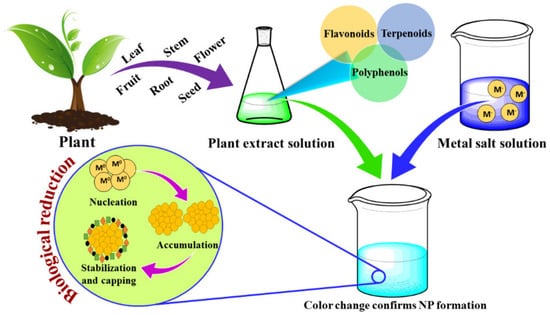
Figure 9.
Plant-mediated synthesis of nanoparticles. Reprinted from Ref. [80].
There are several steps in the proposed synthesis mechanism (Figure 10), including a displacement reaction, and nucleation and growth phases. In previous studies, it has been noted that metal salts and their sulfide source are often reduced by phytochemicals in the plant material during the synthesis of metal sulfide nanoparticles utilizing plant extracts or juices. These bioactive substances function as reducing agents when combined with a plant extract that contains different phytochemicals, such as polyphenols, flavonoids, and terpenoids. They donate electrons to the metal ions, reducing them to form metallic atoms [81]. At the same time, sodium sulfide (Na2S) dissociates into sulfide ions (S2−) in the aqueous solution [82]. The sulfide ions then react with the reduced metal atoms to form metal sulfide nanoparticles.
For instance, Barnwal et al. [83] synthesized CuS nanoparticles using extracts from Azadirachta indica, Syzygium cumini, and Cascabela thevetia. The resulting materials exhibited hexagonal phases with bandgaps ranging from 1.5 to 1.7 eV. Reduced photoluminescence was noted, especially in neem-mediated CuS, indicating lower electron–hole recombination rates. This directly enhances the photocatalytic dye degradation efficiency by promoting better charge carrier separation.
Barnawal et al. [81] further demonstrated that using different plant extracts in a hydrothermal process affected both the particle size and bandgap energies (174–177 eV covellite CuS with 11 nm crystallite sizes). Smaller crystallites contribute to a higher surface area-to-volume ratio, enhancing dye adsorption and facilitating the generation of reactive oxygen species during photocatalysis.
Munyai et al. [84] synthesized CdS nanoparticles from Sutherlandia frutescens, yielding spherical hexagonal nanoparticles with a 3.5 eV bandgap. Although wider bandgaps are traditionally less favorable for visible light absorption, the small particle size compensated by increasing the availability of surface active sites, improving catalytic degradation under UV irradiation.
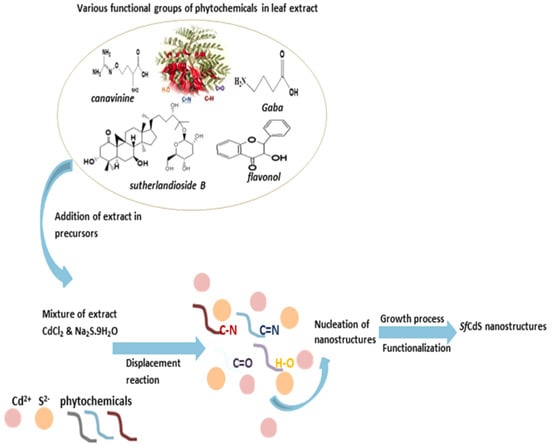
Figure 10.
Probable mechanism for the synthesis of CdS using Sutherlandia frutescens plant extract. Adapted with permission from Ref [84] Copyright 2021 Elsevier.
Ayodhya et al. [85] and Gupta et al. [86] produced CuS nanoparticles using Calotropis gigantea and Ocimum tenuiflorum, respectively. Their synthesized particles exhibited small sizes (10–25 nm) and hexagonal phases, both of which are beneficial for photocatalysis due to enhanced quantum size effects and more efficient light absorption.
Furthermore, Rawat et al. [87] reported flake-like CuS nanoparticles synthesized using an Urtica dioica extract. The flake morphology offers a high proportion of exposed facets, which are catalytically active sites that can improve dye adsorption and degradation rates. Similarly, the use of plant-derived biomolecules can modulate surface charge, affecting the interaction between catalysts and pollutants. In another study by Prasad et al. [88], quasi-spherical NiS nanoparticles (4–27 nm) were synthesized using Asparagus racemosus. These 0D structures provide enhanced surface reactivity and reduce the number of diffusion paths for charge carriers, minimizing recombination and improving catalytic efficiency. Deb et al. [89] synthesized CuS nanorods using starch, and highlighted how one-dimensional (1D) morphologies facilitate directional electron transport, which further suppresses recombination during photocatalysis.
Moreover, Sadhanala et al. [90] synthesized MoS2 nanofibers through green hydrothermal synthesis. Their layered 2D structure, confirmed via TEM, provides numerous edge sites that are critical for catalytic activity, enhancing pollutant degradation through an increased number of active surface areas. FeS thin films were synthesized using a banana peel extract by Saka et al. [91]. The thin film morphology promotes a large surface area, which might be in contact with aqueous pollutants, ensuring efficient degradation through enhanced light harvesting and pollutant diffusion.
Parameshwar et al. [92] and Bhattacharjee et al. [93] also synthesized FeS nanoparticles with different crystal phases (monoclinic and mackinawite), with sizes ranging from 10 to 500 nm. Different crystal structures result in variations in bandgap and electronic properties, affecting how well the material can generate electron–hole pairs and participate in dye degradation under light irradiation.
Furthermore, Wang et al. [94] and Saka et al. [95] reported the synthesis of NiS and FeS using banana peels, which resulted in hexagonal and tetragonal phases, respectively. These structural variations influence electronic configurations, directly affecting light absorption, charge separation, and catalytic reaction rates.
Table 2 provides a comprehensive summary of various plant-mediated synthesis methods for metal sulfide nanoparticles, demonstrating clear differences in particle size, morphology, and crystallinity. These variations are not merely structural distinctions; they play a pivotal role in determining the photocatalytic performance of the resulting materials.

Table 2.
Green synthesis methods for metal sulfides using plants.
Table 2.
Green synthesis methods for metal sulfides using plants.
| Plant(s) | Metal Sulfide | Particle Size | Morphology | Crystal Structure | Ref. and Year |
|---|---|---|---|---|---|
| Azadirachta indica, Syzygium cumini, and Cascabela thevetia | CuS | Spherical | Hexagonal | [83], 2010 | |
| Targetes patula, Azadiracta indica, and Terminallia arjuna | CuS | 11 nm | Covellite | [81], 2017 | |
| S. frutescene | CdS | Spherical | Hexagonal | [84], 2021 | |
| Calotropis gigantea | CuS | 15–25 nm | Polydisperse | Hexagonal | [85], 2010 |
| Ocimum tenuiflorum | CuS | ~10 nm | Spherical | Hexagonal | [86], 2011 |
| Urtica dioica | CuS | 6 nm | Flake-like | Cubic | [87], 2014 |
| Phoenix dactylifera and Urtica dioica | FeS | 68 nm 18–62 nm | Spherical | Mackinawite hexagonal | [93], 1998 |
| Uncaria tomentosa | FeS | 5 to 80 nm | Spherical | - | [96], 2014 |
| Banana peel | NiS | 9nm | Quasi-spherical | Hexagonal | [94], 2019 |
| Banana peel | FeS | - | Grain-like | Tetragonal | [95], 2007 |
| Hordeum vulgare | FeS | 10–500 nm | Spherical | Monoclinic | [92], 2018 |
| Artemisia herba-alba | FeS | 40 nm | Spherical | - | [97], 2016 |
| Aloe vera | CuS | - | - | Covellite | [98], 2016 |
| Acalypha indica | ZnS | 5–20 nm | Spherical | Hexagonal | [99], 2010 |
| Stevia rebaudiana | ZnS | 8.5 nm | Spherical | Cubic | [100], 2016 |
| Jatropha latex | ZnS | 10 nm | Spherical | Cubic | [101], 2012 |
| Aloe vera | PbS | 35–200 nm | Polygonal | Cubic | [102], 2015 |
| Calotropis gigantean | CdS | 20 nm | Spherical | Cubic | [103], 2011 |
| Asparagus racemosus | CdS | 2–8 nm | Spherical | Cubic | [104], 2009 |
| Phyllanthus niruri | ZnS | 2 μm | Hexagonal | Wurzite | [105], 2016 |
| Rosemary | Ag2S | 5–40 nm | Spherical | Cubic | [106], 2013 |
| Diospyros kaki | Ag2S | 82–128 nm | Long nanocluster | Monoclinic | [107], 2020 |
| Cantharanthus roesus | ZnS | 32 nm | Cylindrical | Cubic | [108], 2016 |
| Vegetable oil | Sb2S3 | 8.09–8.27 nm | Nanorods | Orthorhombic stibinite | [109], 2012 |
| Tridaxprocumbens | ZnS | ~40 nm | Radial hexagonal, spherical, rod | Hexagonal wurtzite | [110], 2012 |
| Phyllanthus emblica | ZnS | >100 nm | Spherical | Cubic | [111], 2014 |
| Banana peel | ZnS | 9.09–12.50 nm | Nanoflakes and flowers | Wurtzite and cubic | [112], 2009 |
| Orange fruit peel | ZnS | 3 nm | Spherical | Cubic | [113], 2010 |
| Aloe vera | CdS | - | Spherical | Cubic | [114], 1908 |
| Annona muricata | CdS | 4 nm | Spherical | Cubic | [115], 2014 |
| Banana peel | CdS | 1.48 nm | Wire-like | - | [116], 2015 |
| Watermelon | CdS | 80–90 nm | Spherical | Hexagonal | [117], 2014 |
| Pistacia atlantica | Ag2S | 12–14 nm | Spherical | Monoclinic | [118], 2012 |
| Cochlospermum gossypium | Ag2S | 25 nm | Spherical | Monoclinic | [119], 2012 |
“-” indicates data not reported or not available in the cited reference.
For example, smaller nanoparticles offer a larger surface area, which enhances dye adsorption and increases the density of catalytically active sites available for degradation reactions. Likewise, specific morphologies such as flakes, rods, and spheres significantly influence electron mobility, the pollutant-binding efficiency, and the capacity for light absorption. Furthermore, the crystal structure of the synthesized nanoparticles directly impacts their bandgap energies and electron–hole recombination rates.
In addition, the surface functionalization derived from plant biomolecules during green synthesis can improve nanoparticle dispersion, reduce aggregation, and enhance stability in aqueous systems, thereby facilitating better pollutant–catalyst interactions.
Overall, plant-mediated synthesis not only provides an eco-friendly and sustainable route for fabricating metal sulfide nanoparticles, but also enables precise control over the physicochemical properties that govern dye degradation efficiency. Future research should therefore prioritize optimizing plant extract compositions and synthesis parameters to refine the size, morphology, and electronic properties for superior catalytic applications in wastewater treatment.
5. Photocatalytic Degradation of Dyes Using Metal Sulfides Synthesized Using Plants
The persistence of synthetic dyes in wastewater presents serious environmental and public health concerns due to their toxicity, non-biodegradability, and potential carcinogenicity [95]. The conventional methods for dye removal, including adsorption and chemical oxidation, often suffer from secondary pollution or high operational costs. As a result, photocatalytic degradation has emerged as a promising, eco-friendly solution for wastewater remediation. In this context, metal sulfides (MSs) have garnered significant attention due to their unique semiconducting properties, with bandgaps typically ranging from 1.2 eV (e.g., Cu2S) to 3.7 eV (e.g., ZnS), facilitating visible light-driven catalysis [73].
Recently, plant-mediated synthesis of metal sulfides has gained momentum as an environmentally benign and cost-effective approach for the synthesis of photocatalysts. The phytochemicals in plant extracts, such as flavonoids, terpenoids, and alkaloids, serve as natural reducing and capping agents, eliminating the need for hazardous chemicals in nanoparticle synthesis. This method also introduces unique surface functionalities that can improve catalytic performance by enhancing charge transfer and increasing the number of active surface sites.
Recent studies have highlighted that plant-mediated synthesis of metal sulfide photocatalysts enhances dye degradation performance not merely due to the inherent properties of metal sulfides, but because of the unique characteristics imparted by green synthesis routes. For instance, Munyai et al. [84] synthesized CdS nanoparticles using Sutherlandia frutescens, where the phytochemicals in the plant extract acted as both reducing and stabilizing agents, resulting in small, spherical nanoparticles with an enhanced surface area. This morphology facilitates better light absorption and more active sites for pollutant interaction, leading to effective photocatalytic activity under UV light.
Similarly, Ayodhya et al. [85,103] demonstrated that CuS and CdS nanoparticles synthesized using plant extracts show improved photocatalytic behaviors due to the formation of smaller particle sizes and blue-shifted absorption edges. This shift indicates bandgap modulation, allowing for better charge separation and extended absorption into the visible range, which is particularly beneficial under solar irradiation.
In another study, Ag2S nanoparticles synthesized from Cochlospermum gossypium [119] also exhibited significant dye degradation, which can be attributed to the bio-functionalization of the nanoparticle surface. The capping agents from the plant extract introduced functional groups that improved pollutant adsorption and facilitated electron transfer during photocatalysis.
Moreover, Kannan et al. [120] reported that ZnS nanoparticles derived from Tridax procumbens displayed enhanced catalytic activity due to their lower bandgap (2.96 eV), increased porosity, and large surface area (132 m2/g) (Figure 11). These properties, often influenced by plant-derived metabolites, lead to efficient electron–hole pair separation, reduce recombination rates, and increase the availability of reactive sites, all of which collectively enhance dye degradation under visible light.
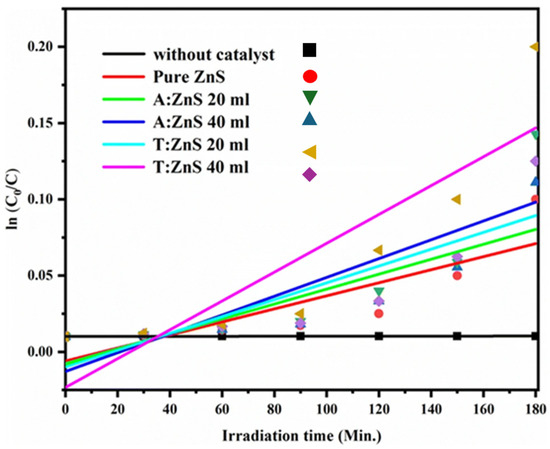
Figure 11.
Kinetic studies for the degradation of methylene blue dye using ZnS/A:ZnS/T:ZnS nanoparticles. Colored lines represent linear regression fits, while the corresponding-colored shapes next to the sample name indicate the experimental data points. Adapted with permission from Ref [120] Copyright 2020 Springer Nature.
Further advancements in the green synthesis of metal sulfide photocatalysts have demonstrated their versatility and effectiveness in degrading a broad spectrum of dye pollutants under diverse light conditions. For example, Ayodhya et al. [121] employed xanthan gum as a capping and stabilizing agent during CuS nanoparticle synthesis, which not only prevented particle aggregation but also introduced surface functional groups that enhanced pollutant adsorption and electron transfer. This strategy facilitated the degradation of multiple dyes including methylene blue, rhodamine B, eosin Y, and Congo red under solar, visible, and ultraviolet light. The multifunctionality of the surface groups derived from xanthan gum likely contributed to the broad-spectrum catalytic activity, enabling interactions with structurally different dye molecules.
Similarly, Haijani et al. [122] utilized a Kalanchoe plant extract for the synthesis of CuS nanoparticles, where the biomolecules in the extract influenced the formation of nanoscale particles with high catalytic surface activity. The enhanced kinetic rate (k = 0.226 min−1) observed for Yellow 3G dye degradation indicates efficient charge carrier generation and reduced recombination, key factors in achieving rapid photocatalysis under visible light.
In another study, Veerabhadram et al. [123] synthesized CuS nanoparticles using Calotropis gigantea, benefiting from the plant extract’s reducing and capping functions. The resulting nanoparticles maintained high surface reactivity and effective dye–catalyst interactions, promoting rapid degradation of Safranin O under sunlight.
Expanding beyond copper sulfide systems, Spoorthi et al. [124] synthesized bismuth sulfide (Bi2S3) nanoparticles using Celosia argentea flower extract (Figure 12). The layered Bi2S3 structure combined with bio-assisted surface modifications enhanced the photocatalytic degradation of methylene blue under UV light. However, the degradation efficiencies for other dyes—such as methyl orange, rhodamine B, and erythrosin B—varied significantly. This highlights how dye structure, molecular size, and specific catalyst–pollutant interactions influence photocatalytic outcomes, even when using the same catalyst.
Furthermore, Ullah et al. [125] demonstrated the green synthesis of CdS nanoparticles using Dicliptera roxburghiana. The biofunctionalization during synthesis not only stabilized the nanoparticles but also tailored their optical properties for visible-light activation, enabling effective methylene blue degradation within 120 min under sunlight. The ability to harness solar energy effectively is a key advantage of these green-synthesized materials.
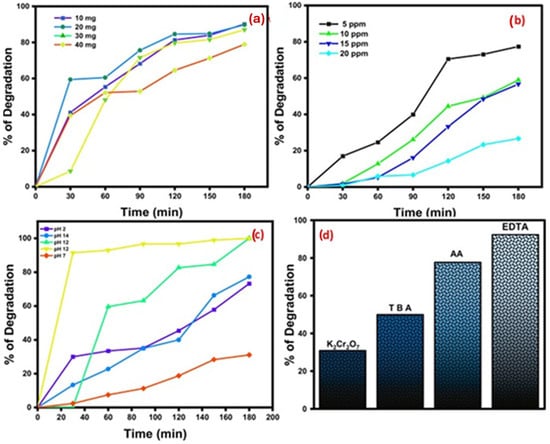
Figure 12.
(a) Effects of pH on dye degradation, (b) dye concentration, (c) catalyst dose, and (d) scavenging ability (K2Cr2O7, AA, TBA and EDTA) in investigations on MB dye degradation Adapted with permission from Ref [124] Copyright 2024 Elsevier.
Plant-mediated synthesis of zinc sulfide (ZnS) photocatalysts has demonstrated significant potential due to the structural and electronic modifications induced by phytochemical interactions during nanoparticle formation. For example, Munyai et al. [126] synthesized ZnS nanoparticles using a Sutherlandia frutescens extract, where bioactive compounds contributed to particle stabilization and surface functionalization. This led to enhanced surface area and activesite exposure, which facilitated efficient electron–hole generation and pollutant interaction during malachite green (MG) degradation under UV light. Additionally, the photocatalyst’s recyclability over multiple cycles while maintaining over 65% efficiency highlights the role of green synthesis in producing more stable and reusable materials.
In a related study, Ouni et al. [127] prepared ZnS nanoparticles with a blue-shifted cubic phase, achieving improved photocatalytic performance under sunlight. The small crystallite size (4 nm) and large surface area (37 m2/g) were directly linked to better photon absorption and more reactive sites for dye adsorption and degradation. The blue shift indicates bandgap tuning during green synthesis, likely due to plant metabolite interactions controlling the particle nucleation and growth.
Expanding to multi-metal sulfide systems, Nsude et al. [128] synthesized CuFeS2 nanoparticles using a Mimosa pudica extract. The synergistic combination of copper and iron within the sulfide lattice, coupled with plant-mediated surface modifications, facilitated effective degradation of methylene blue under visible light. The process was primarily driven by the generation of hydroxyl radicals (•OH), highlighting the dominant role of reactive oxygen species (ROS) in these catalytic systems.
Complementing these findings, Dadmehr et al. [129] reported the green synthesis of CdS quantum dots (QDs) for rhodamine B degradation. The study revealed that photocatalytic activity increased significantly at an alkaline pH (pH 9). This was attributed to improved electron–hole pair separation and enhanced radical formation at higher pHs, demonstrating how reaction conditions and the green-synthesized material’s surface chemistry can be tuned for optimized performance.
Green-synthesized metal sulfide photocatalysts have demonstrated significant potential for dye degradation due to their unique structural and surface properties imparted by plant-derived bioactive compounds (Table 3). These phytochemicals act as natural capping and stabilizing agents, introducing surface defects, functional groups, and size control mechanisms that collectively enhance the photocatalysts’ charge separation, electron transport, and pollutant adsorption. Additionally, plant-mediated routes often lead to bandgap modulation, enabling activation under visible light which is a critical advantage over traditional UV-active photocatalysts. The use of renewable plant materials also ensures eco-friendliness and cost-effectiveness, eliminating the need for hazardous chemicals.

Table 3.
Degradation of dyes using plant-derived metal sulfides.
Table 3.
Degradation of dyes using plant-derived metal sulfides.
| Plant Species | Catalyst | Dye | Type of Light/Light Source | Bandgap (eV) | DosageConcentration | IrradiationTime | % Degradation | Ref. and Year |
|---|---|---|---|---|---|---|---|---|
| S. frutescence | CdS | MG | UV, 300 W | 3.55 Ev | 50 mg 10 mg/L | 60 | 91 | [84], 2021 |
| Colotropis gigantea tea | CuS | SO | Sunlight | - | 10–50 mg/L | 60 | 81 | [85], 2010 |
| Colotropis gigantea leaf | CdS | MB EY | Sunlight | 2.42 eV | 60 | 100 | [103], 2011 | |
| Cochlospernum gossypium | Ag2S | FL | Solar light | [119], 2012 | ||||
| Ficus johanis | ZnS | Mercury lamp | 290–320 nm 3.84 | 10 mg/L | 100 | [130], 2011 | ||
| Xanthan gum | CuS | MB RB EY CR | Sunlight | 30 mg | 240 | 90 69 29 60 | [121], 2023 | |
| Kalanchoe | CuS | Yellow 3G | 300 W xenon lamp | 0.2 g/L | 120 | 77 | [122], 2016 | |
| Calotropis gigantea | CuS | S O | Sunlight | 2.76 | 0.05 g/L | 60 | 81 | [123], 2023 |
| Celosia aregentea flower | Bi2S3 | MB MO RhB EB | UV | 3.17 | 10 mg 5 ppm | 180 | 90 7 19 75 | [121], 2023 |
| Dicliptera roxburghiana | CdS | MB | Sunlight | 3.31 | 5 mg 10 ppm | 120 | 87 | [125], 2024 |
| Sutherlandia frutescens | ZnS | MG | 300 W UV lamp | 3.6 | 25–100 mg 10 ppm | 60 | 90 | [126], 2021 |
| Artemisia herba alba | ZnS | MB | Sunlight | 3.70 | 20 mg 10 ppm | 180 | 94 | [127], 2022 |
| Mimosa | CuFeS2 | MB | Visible | 90 | 98 | [128], 2020 | ||
| Crocus sativus L. | CdS | RhB | UV light | 2.4 Ev | 0.03 mg 3 ppm | 80 | 92 | [129], 2022 |
SO—Safranin O; MB—methylene blue; CV—Crystal Violet; MG—malachite green; RhB—rhodamine blue; CR—Congo red; EY—eosin; MO—methyl orange. “-” indicates data not reported or not available in the cited reference.
However, this approach presents notable challenges. The variability in plant extract composition influenced by geographic and seasonal factors can lead to inconsistencies in nanoparticle morphology, crystallinity, and catalytic performance. Furthermore, scaling up green synthesis methods for industrial applications remains difficult, and issues such as catalyst stability, metal ion leaching, and limited mechanistic understanding of the role of individual phytochemicals require further study.
The correlation between green synthesis methods and enhanced photocatalytic activity is largely attributed to surface functionalization, size reduction, and improved optical properties, which directly impact the dye degradation efficiency. Moving forward, strategies such as doping, heterojunction formation, and coupling with carbon materials are being explored to overcome the current limitations and realize the full potential of plant-mediated metal sulfide photocatalysts in environmental remediation.
6. The Limitations of and Future Perspectives for Using Green Metal Sulfides as Photocatalysts for Dye Degradation
The photocatalytic degradation of organic contaminants—such as dyes, pesticides, and phenolic compounds—in aqueous environments is influenced by several key factors. These include the bandgap energy, phase composition, and surface area of the photocatalyst, as well as its electron–hole recombination rate, the intensity of incident light, and the material’s adsorption capacity for dye molecules. Among these parameters, the rapid recombination of photogenerated electron–hole pairs remains a major limitation, as it significantly reduces photocatalytic efficiency. To address this challenge, various strategies have been employed to promote effective charge separation. One widely adopted approach involves the construction of heterojunctions between two semiconductor materials, which facilitates improved charge carrier dynamics (Figure 13).
Pure metal chalcogenides, including metal sulfides, often exhibit limited photocatalytic efficiency due to insufficient light absorption and the rapid recombination of charge carriers [131]. These drawbacks can be mitigated by incorporating metallic or non-metallic charge separators, which introduce new charge transfer pathways at the semiconductor interface. This modification not only enhances electron–hole separation, but also reduces recombination, ultimately improving photocatalytic performance [132].
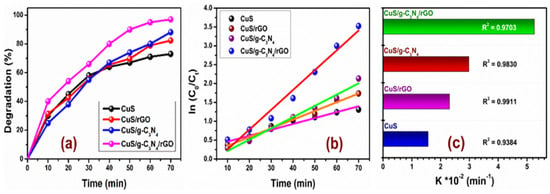
Figure 13.
(a) MG photocatalytic degradation, (b) MG degradation kinetics fitting curves, and (c) regression coefficient and rate constant values Adapted with permission from Ref [133] Copyright 2024 Elsevier.
One effective strategy for enhancing the photocatalytic performance of metal sulfides (MSs) is incorporating carbon nanotubes (CNTs) into their nanostructures. The resulting MS–CNT hybrids combine the advantageous properties of both materials, offering synergistic effects that significantly improve catalytic behavior. Carbon nanotubes, with their one-dimensional structure, possess exceptional features such as a large specific surface area, low density, and superior electrical conductivity [132]. These properties facilitate more efficient charge transport and reduce electron–hole recombination, leading to enhanced photocatalytic activity compared to pristine metal sulfide materials [133].
In the case of zinc sulfide (ZnS), its wide bandgap restricts its activation wavelengths primarily to UV irradiation, limiting its practical applications [134]. To overcome this, several strategies have been explored to improve ZnS’s photocatalytic efficiency, including morphology modification [135,136], metal ion doping [137], non-metal ion doping [138], dye sensitization [139], the formation of composite semiconductors, and the introduction of surface defects [140]. These approaches effectively extend the photocatalytic response of ZnS into the visible region, broadening its environmental and energy-related applications.
Similarly, cerium sulfide (Ce2S3) has shown limited photocatalytic use due to its wide bandgap and poor solar energy utilization. Kandhasamy et al. [141] addressed this challenge by employing various enhancement techniques such as elemental doping, noble metal deposition, and the construction of heterojunction structures. Notably, the fabrication of a Ce2S3–NiS2/reduced graphene oxide (rGO) nanocomposite resulted in remarkable photocatalytic degradation efficiency, which was attributed to the improved light absorption and superior charge separation provided by the carbon material (Figure 14).
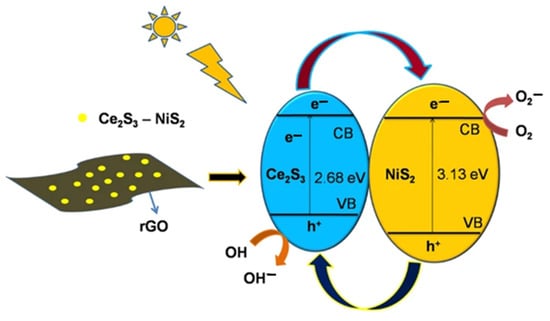
Figure 14.
Ce2S3-NiS2/rGO photocatalysts for environmental remediation Adapted with permission from Ref [141] Copyright 2022 Springer Nature.
Cadmium sulfide (CdS) has recently attracted significant attention as a semiconductor photocatalyst due to its strong visible light absorption capabilities, making it effective for pollutant degradation. However, CdS faces challenges related to photocorrosion, where photo-generated positive holes lead to lattice dissolution or the formation of an insulating elemental sulfur layer on the particle surface, which diminishes its catalytic activity [141]. Metal doping has emerged as a critical strategy for improving the photocatalytic performance of CdS (Figure 15). The introduction of dopants, co-catalysts, and composite materials effectively enhances the charge separation, light absorption, and overall photocatalytic efficiency by modifying the electronic structure of CdS [142].
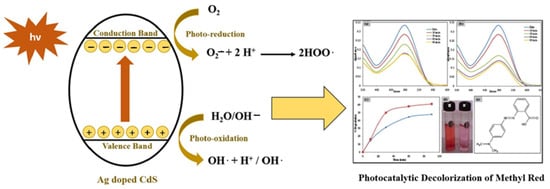
Figure 15.
Photocatalytic degradation process and results of MR dye degradation by pure CdS and Ag-doped CdS Adapted with permission from Ref [142] Copyright 2022 Elsevier.
NiS2 nanostructures, such as nanoparticles, hollow microspheres, nanowires, and nanosheets, have garnered considerable interest as promising semiconducting materials for catalytic applications due to their stability, affordability, and low toxicity [143]. Despite these advantages, their photocatalytic efficiency remains limited by factors such as a low quantum efficiency [144], susceptibility to photocorrosion, and rapid recombination of photogenerated electron–hole pairs [145]. To address these challenges, extensive research efforts have focused on strategies including doping (Figure 16) and structural modifications to enhance the photocatalytic performance of NiS2-based materials.
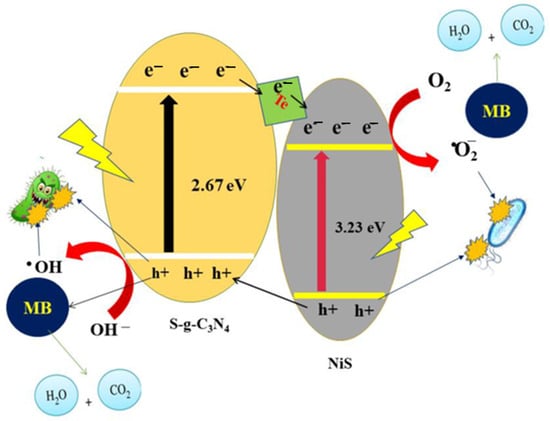
Figure 16.
Diagram of antibacterial and catalytic dye degradation processes using SGCN/Te@NiS NCs in the presence of sunlight. Upper arrows (black): Photogenerated electrons (e−) transfer from S-g-C3N4 (2.67 eV) to NiS (3.23 eV), facilitating charge separation. These electrons reduce CO2 or react with H2O to form •OH radicals. Lower arrows (blue): Holes (h+) migrate to the S-g-C3N4 surface, oxidizing H2O or pollutants directly. The synergistic effect of the heterojunction enhances photocatalytic activity for CO2 reduction and organic degradation. Reprinted from Ref. [145].
Green-synthesized metal sulfides face several limitations as photocatalysts for dye degradation, primarily due to instability under prolonged exposure, rapid electron–hole recombination, and limited light absorption. Many pure metal sulfides, such as ZnS, possess wide bandgaps, restricting their activity to UV light, thereby necessitating modifications like metal-ion doping and heterojunction formation to enhance their visible-light responsiveness. Although CdS effectively absorbs visible light, it suffers from photocorrosion, which diminishes its durability; approaches including co-catalyst doping and composite formation have been investigated to address this issue. NiS2, known for its stability and non-toxicity, displays low quantum efficiency resulting from fast charge recombination, thus requiring structural alterations to improve its photocatalytic performance. The integration of carbon nanotubes into CuS nanostructures has demonstrated improved charge separation and enhanced catalytic activity. Similarly, Ce2S3’s wide bandgap limits its solar utilization, prompting research into noble metal deposition and heterojunction engineering to boost its efficiency. While green synthesis offers sustainable and environmentally friendly routes, substantial advances in material design and engineering remain essential for increasing the photocatalytic efficiency of metal sulfides to levels suitable for industrial-scale wastewater treatment.
7. Heterostructures of Green Metal Sulfides as Photocatalysts for Degradation of Dyes
Metal sulfides have recently attracted significant attention due to their narrow bandgap, high conduction band (CB) position, and broad-spectrum light absorption, which contrast with the properties of metal oxides [146]. However, the narrow bandgap also leads to rapid charge recombination, while the elevated CB limits the material’s redox potential. Consequently, pure metal sulfides often exhibit low photocatalytic activity. This low efficiency is primarily due to the large concentration of photogenerated holes, which have limited mobility, restricting their availability for oxidation reactions [147]. Current research is focusing on designing highly active, stable, and cost-effective photocatalysts with improved performance using various methods (Figure 17). Enhancing visible light absorption through surface modification or doping is a common strategy. Among these, constructing heterojunction structures has emerged as an effective approach, offering two key advantages: (i) broadening the photoresponse range of semiconductor materials and (ii) promoting efficient separation of photogenerated electron–hole pairs, thereby reducing recombination losses and improving photocatalytic efficiency [148].
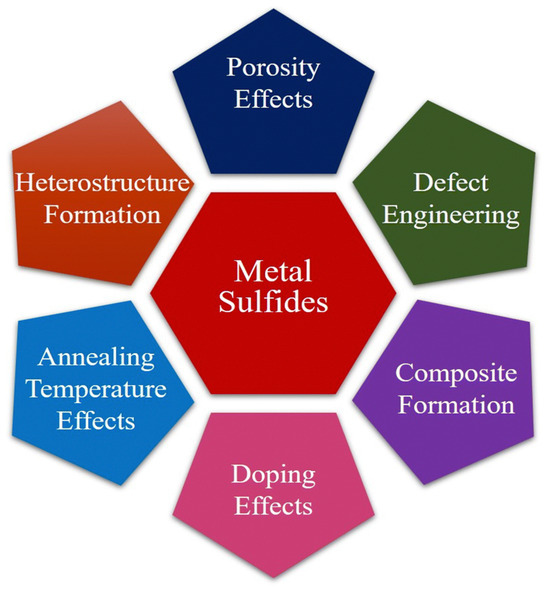
Figure 17.
Methodical techniques to improve metal sulfide system performance. Reprinted from Ref. [146].
Recent studies further demonstrated the efficacy of hybrid heterostructures incorporating carbonaceous materials and noble metals (Figure 18). For instance, Cao et al. [149] fabricated a three-dimensional rGO/g-C3N4/Ag nanocomposite capable of adsorbing and degrading ~50 mg MB g−1 in 60 min under visible light. Similarly, Abdrashitova et al. [150] reported that Ag-doped ZnO/MWCNT composites achieved >95% RhB degradation within 12 min, an enhancement attributed to improved charge separation and plasmonic effects. These findings emphasize the value of graphene- and CNT-based heterostructures in enhancing photocatalytic performance, strategies that are readily adaptable to metal sulfide systems.
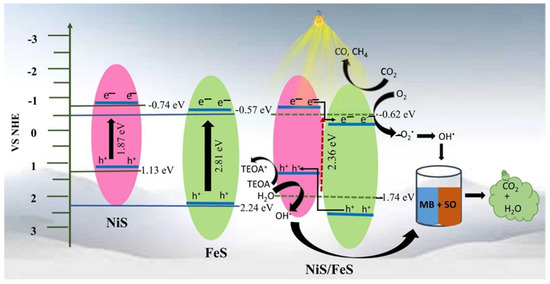
Figure 18.
Photocatalytic mechanism of CRR Adapted with permission from Ref [151] Copyright 2025 Elsevier.
By employing the green synthesis approach, a Kalanchoe plant extract was utilized in the study by Hajiani et al. [123] to produce CuS@Fe3O4 nanoparticles for the degradation of Yellow 3G dye. The photocatalytic degradation took place for a period of 90 min under light exposure and the percentage efficiency of 92.35% was achieved. Utilizing a plant extract from M. oleifera, green CuS/Ni and CuS/Co were created utilizing the green synthesis method to break down metanil yellow. After 105 min of light irradiation, the percentage efficiencies for CuS/Ni and CuS/Co were 91.8 and 93.9, respectively.
In a recent study, Vyas et al. [152] demonstrated the use of green-synthesized carbon quantum dot-decorated copper sulfide (CQDs@CuS) for the photocatalytic degradation of brilliant green dye (Figure 19). The researchers investigated the effect of catalyst dosage by varying the amount of CQDs@CuS from 0.01 g to 0.17 g. Their results showed a significant improvement in degradation efficiency, with the breakdown rate of brilliant green increasing from 23.7% to 91.8% as the catalyst dosage increased from 0.01 g to 0.09 g. This enhancement highlights the critical role of optimal catalyst loading in maximizing photocatalytic performance.
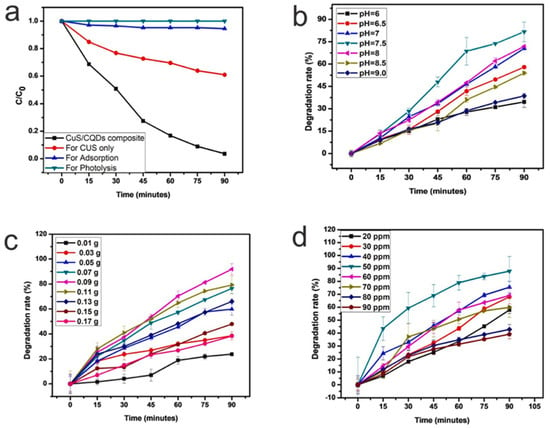
Figure 19.
(a) Comparative analyses of decay rates, photolysis, and adsorption of CuS alone and CuS/CQDs composite. (b) Effect of pH, which ranged from 6.0 to 9.0, on dye degradation. (c) Effect of catalyst dose, which ranged from 0.01 g to 0.17 g. (d) Dye concentration changes from 20 ppm to 90 ppm Adapted with permission from Ref [152] Copyright 2022.
As summarized in Table 4, coupling metal sulfides with secondary materials such as transition metals (Fe, Ni, or Co), Fe3O4, biochar, or carbon quantum dots leads to synergistic improvements in photocatalytic performance. These enhancements stem from several mechanistic advantages. Heterojunction formation improves charge carrier separation, minimizing electron–hole recombination, which is a major limitation in pure metal sulfides. Additionally, combining different materials broadens the light absorption spectrum, allowing the catalyst to respond to a wider range of irradiation, including irradiation from sunlight, xenon, tungsten, and UV lamps. This strategy also introduces more active catalytic sites, increasing dye molecule adsorption and facilitating redox reactions on the catalyst surface.

Table 4.
Degradation of dyes using plant-derived metal sulfide heterojunctions.
Table 4.
Degradation of dyes using plant-derived metal sulfide heterojunctions.
| Plant Species | Catalyst | Pollutant | Light Source | Dosage | IrradiationTime | % Degradation | Ref. and Year |
|---|---|---|---|---|---|---|---|
| Mimosa pudica | CuFeS2 | MB | Sunlight | 30 mg | 90 | 98 | [153], 2020 |
| Kalanchoe | CuS@Fe3O4 | Yellow 3G | 300 W xenon lamp | 0.2 g/L | 120 | 92.35 | [123], 2023 |
| Azadrichta indica | NiS@ Biochar | Tinidazole | Sunlight | 0.011 g | 110 | 89.14 | [154], 2024 |
| Eichhornia crassipes | CQDs/CuS | Brilliant green | Tungsten lamp of 200 W | 0.09 g | 100 | 96.3 | [152], 2022 |
| M. oleifera | CuS/Ni CuS/Co | Metanil yellow | - | 6 mg | 105 | 91.8 93.9 | [155], 2023 |
| Calotropis procera | FeS/NiS | SO MB | 300 W Xe lamp | 30 mg 10 ppm | 100 | 77 81 | [34], 2021 |
“-” indicates data not reported or not available in the cited reference.
The photocatalytic efficiencies reported for these heterojunctions were consistently high, with most studies recording dye degradation rates between 77% and 98%, depending on catalyst composition and operational parameters. These results highlight the role of heterojunctions in improving light utilization and prolonging electron lifetime, thus accelerating the degradation kinetics.
Catalyst dosage was another critical factor influencing photocatalytic activity. In the reviewed studies, the dosages were as low as 6 mg. Generally, increased catalyst loading improved dye degradation due to the availability of more active sites for photocatalytic reactions. However, there is an optimum loading beyond which efficiency may decline due to light scattering or nanoparticle agglomeration, reducing the effective surface area. Furthermore, the type of heterojunction material and plant source also played a significant role in determining the photocatalytic performance.
The use of plant extracts in synthesizing these heterojunctions not only aligns with green chemistry principles but also introduces unique phytochemical functional groups that can influence catalytic behavior. Biomolecules from plant extracts serve as reducing, capping, and stabilizing agents, promoting uniform particle sizes, preventing agglomeration, and enhancing dispersion.
The formation of plant-mediated metal sulfide heterojunctions significantly enhances photocatalytic dye degradation by improving charge separation, increasing the number of active sites, and enabling broader light absorption. The reviewed studies demonstrate that variations in catalyst dosage, heterojunction composition, plant source, and irradiation time directly influence photocatalytic efficiencies, often resulting in degradation rates exceeding 90%. Future research should focus on optimizing synthesis protocols, scaling up production, and applying these systems to a broader range of pollutants beyond dyes, including pharmaceuticals and industrial contaminants. This approach holds promise for the development of cost-effective, sustainable solutions for wastewater treatment.
8. Conclusions
The synthesis of metal sulfide-based photocatalysts represents a promising and sustainable strategy for addressing dye-induced water pollution. This review has emphasized the substantial progress made in green synthesis methods, particularly those utilizing plant extracts, which provide the dual advantages of environmental sustainability and enhanced photocatalytic properties. The incorporation of heterojunction structures and advanced oxidation processes has further improved charge separation efficiency and broadened the applicability of metal sulfides to a wider spectrum of organic contaminants. Notably, the reported high degradation efficiencies under both simulated and natural light conditions highlight the practical potential of these materials for real-world wastewater treatment applications.
Despite these advancements, several challenges remain. Future research should prioritize improving the structural and photochemical stability of metal sulfides under prolonged operational conditions, as their susceptibility to photocorrosion and charge recombination still limits their real-world applicability. Furthermore, the development of novel, scalable green synthesis methods—particularly those that allow for precise control over the morphology, composition, and surface chemistry of metal sulfides—will be essential. Continued exploration of heterostructure design, including Z-scheme and S-scheme configurations, may further enhance visible-light absorption and photocatalytic efficiency. Finally, systematic evaluation of the environmental impacts, cost-effectiveness, and scalability will be critical to fully establish the role of green-synthesized metal sulfides in sustainable wastewater treatment technologies.
Author Contributions
Conceptualization, N.C.H.-M. and N.M.; formal analysis and investigation, C.D.L., N.M. and N.C.H.-M.; writing—original draft preparation, C.D.L.; writing—review and editing N.M. and N.C.H.-M.; supervision and funding acquisition, N.M. and N.C.H.-M. All authors have read and agreed to the published version of the manuscript.
Funding
This research was funded by NRF/Sasol grant number [PMDS230704126787].
Acknowledgments
The authors greatly acknowledge the contribution made by the UL Research Supervisor incentive fund and the NRF/Sasol Inzalo.
Conflicts of Interest
The authors declare no conflicts of interest.
References
- Kumar, P.S.; Joshiba, G.J.; Femina, C.C.; Varshini, P.; Priyadharshini, S.; Karthick, M.A.; Jothirani, R. A Critical Review on Recent Developments in the Low-Cost Adsorption of Dyes from Wastewater. Desalin. Water Treat. 2019, 172, 395–416. [Google Scholar] [CrossRef]
- Batalhão, A.C.; Bouloumytis, V.; Zuffo, A.C.; Pimentel da Silva, L. Integrated Water Resources Management and Urban Sustainability. In The Route Towards Global Sustainability: Challenges and Management Practices; Springer International Publishing: Cham, Switzerland, 2023; pp. 289–312. [Google Scholar]
- Shindhal, T.; Rakholiya, P.; Varjani, S.; Pandey, A.; Ngo, H.H.; Guo, W.; Ng, H.Y.; Taherzadeh, M.J. A Critical Review on Advances in the Practices and Perspectives for the Treatment of Dye Industry Wastewater. Bioengineered 2021, 12, 70–87. [Google Scholar] [CrossRef]
- Ogugbue, C.J.; Sawidis, T. Optimisation of Process Parameters for Bioreduction of Azo Dyes Using Bacillus firmus under Batch Anaerobic Condition. Int. J. Environ. Stud. 2011, 68, 651–665. [Google Scholar] [CrossRef]
- Rajkumar, D.; Kim, J.G. Oxidation of Various Reactive Dyes with In Situ Electro-Generated Active Chlorine for Textile Dyeing Industry Wastewater Treatment. J. Hazard. Mater. 2006, 136, 203–212. [Google Scholar] [CrossRef]
- Dutta, S.; Gupta, B.; Srivastava, S.K.; Gupta, A.K. Recent Advances on the Removal of Dyes from Wastewater Using Various Adsorbents: A Critical Review. Mater. Adv. 2021, 2, 4497–4531. [Google Scholar] [CrossRef]
- Kishor, R.; Purchase, D.; Saratale, R.G.; Saratale, L.F.; Ferreira, L.F.R.; Bilal, M.; Chandra, R.; Bharagava, R.N. Ecotoxicological and Health Concerns of Persistent Coloring Pollutants of Textile Industry Wastewater and Treatment Approaches for Environmental Safety. J. Environ. Chem. Eng. 2021, 9, 105012. [Google Scholar] [CrossRef]
- Henze, M.; Harremoes, P.; Jansen, J.L.; Arvin, E. Wastewater Treatment: Biological and Chemical Process; Springer: Berlin/Heidelberg, Germany, 2002. [Google Scholar]
- Aus der Beek, T.; Weber, F.A.; Bergmann, A.; Hickmann, S.; Ebert, I.; Hein, A.; Küster, A. Pharmaceuticals in the Environment—Global Occurrences and Perspectives. Environ. Toxicol. Chem. 2016, 35, 823–835. [Google Scholar] [CrossRef] [PubMed]
- Zwiener, C.; Frimmel, F.H. Short-Term Tests with a Pilot Sewage Plant and Biofilm Reactors for the Biological Degradation of the Pharmaceutical Compounds Clofibric Acid, Ibuprofen, and Diclofenac. Sci. Total Environ. 2003, 309, 201–211. [Google Scholar] [CrossRef] [PubMed]
- Khasawneh, O.F.S.; Palaniandy, P. Photocatalytic Degradation of Pharmaceuticals Using TiO-Based Nanocomposite Catalyst—Review. Civ. Environ. Eng. Rep. 2019, 29, 1–33. [Google Scholar]
- Rai, P.K. Heavy Metal Pollution in Aquatic Ecosystems and Its Phytoremediation Using Wetland Plants: An Ecosustainable Approach. Int. J. Phytoremediation 2008, 10, 133–160. [Google Scholar] [CrossRef]
- Tsalas, N.; Golfinopoulos, S.K.; Samios, S.; Katsouras, G.; Peroulis, K. Optimization of Energy Consumption in a Wastewater Treatment Plant: An Overview. Energies 2024, 17, 2808. [Google Scholar] [CrossRef]
- Anjaneyulu, Y.; Sreedhara Chary, N.; Samuel Suman Raj, D. Decolourization of Industrial Effluents—Available Methods and Emerging Technologies—A Review. Rev. Environ. Sci. Biotechnol. 2005, 4, 245–273. [Google Scholar] [CrossRef]
- Rathi, B.S.; Kumar, P.S. Application of Adsorption Process for Effective Removal of Emerging Contaminants from Water and Wastewater. Environ. Pollut. 2021, 280, 116995. [Google Scholar] [CrossRef]
- Singla, A. Review of Biological Treatment Solutions and Role of Nanoparticles in the Treatment of Wastewater Generated by Diverse Industries. Nanotechnol. Environ. Eng. 2022, 7, 699–711. [Google Scholar] [CrossRef]
- Chaplin, B.P. The Prospect of Electrochemical Technologies Advancing Worldwide Water Treatment. Acc. Chem. Res. 2019, 52, 596–604. [Google Scholar] [CrossRef]
- Peters, T. Membrane Technology for Water Treatment. Chem. Eng. Technol. 2010, 33, 1233–1240. [Google Scholar] [CrossRef]
- O’Shea, K.E.; Dionysiou, D.D. Advanced Oxidation Processes for Water Treatment. J. Phys. Chem. Lett. 2012, 3, 2112–2113. [Google Scholar] [CrossRef]
- Mudhoo, A.; Paliya, S.; Goswami, P.; Singh, M.; Lofrano, G.; Carotenuto, F.; Carraturo, G.; Libralato, M.; Guida, M.; Usman, M.; et al. Fabrication, Functionalization and Performance of Doped Photocatalysts for Dye Degradation and Mineralization: A Review. Environ. Chem. Lett. 2020, 18, 1825–1903. [Google Scholar] [CrossRef]
- Kumari, H.; Sonia, R.; Suman, R.; Chahal, S.; Devi, S.; Sharma, S.; Kumar, P.; Kumar, S.; Kumar, A.; Kumar, R. A Review on Photocatalysis Used for Wastewater Treatment: Dye Degradation. Water Air Soil. Pollut. 2023, 234, 349. [Google Scholar] [CrossRef]
- Far, H.S.; Najafi, M.; Hasanzadeh, M.; Rahimi, R. Synthesis of MXene/Metal-Organic Framework (MXOF) Composite as an Efficient Photocatalyst for Dye Contaminant Degradation. Inorg. Chem. Commun. 2023, 152, 110680. [Google Scholar]
- Araujo, R.N.; Nascimento, E.P.; Firmino, H.C.T.; Macedo, D.A.; Neves, G.A.; Morales, M.A.; Menezes, R.R.R. α-Fe2O3 Fibers: An Efficient Photocatalyst for Dye Degradation under Visible Light. J. Alloys Compd. 2021, 882, 160683. [Google Scholar] [CrossRef]
- Mohajerani, M.; Mehrvar, M.; Ein-Mozaffari, F. An Overview of the Integration of Advanced Oxidation Technologies and Other Processes for Water and Wastewater Treatment. Int. J. Eng. 2009, 3, 120–146. [Google Scholar]
- Kanakaraju, D.; Glass, B.D.; Oelgemöller, M. Advanced Oxidation Process-Mediated Removal of Pharmaceuticals from Water: A Review. J. Environ. Manage 2018, 219, 189–207. [Google Scholar] [CrossRef] [PubMed]
- Arnal, J.M.; Sancho, M.; García-Fayos, J.; Lora-García, M.A. Advanced Oxidation Processes for Water Disinfection: A Practical Review. Desalin. Water Treat. 2013, 51, 1723–1734. [Google Scholar]
- Barba, C.; Martínez-Huitle, M.J.; Brillas, E. Decontamination of Water Containing Pharmaceutical Residues by Electrochemical Advanced Oxidation Processes: A Review. Curr. Opin. Electrochem. 2020, 22, 115–126. [Google Scholar]
- Patra, R.; Dash, P.K.; Panda, P.; Yang, P.C. A Breakthrough in Photocatalytic Wastewater Treatment: The Incredible Potential of g-C3N4/Titanate Perovskite-Based Nanocomposites. Nanomaterials 2023, 13, 2173. [Google Scholar] [CrossRef]
- Gupta, S.K.; Singh, R. Photocatalytic Degradation of Dye Effluent Using TiO2 as Photocatalyst: A Review. J. Environ. Chem. Eng. 2021, 9, 105801. [Google Scholar]
- Wei, H.; Zhang, C.; Cheng, Z.; Zhang, Y. Fenton Oxidation for Wastewater Treatment: Advances and Challenges. Chem. Eng. J. 2022, 430, 133218. [Google Scholar]
- Molinari, R.; Argurio, C.; Drioli, E.; Avella, A. Innovative hybrid membrane processes for water treatment and desalination. Desalination 2001, 138, 241–246. [Google Scholar]
- Dionysiou, D. Advanced oxidation technologies in water treatment: The journey of environmental chemistry. Environ. Sci. Technol. Lett. 2018, 5, 155–160. [Google Scholar]
- Pathania, S.; Hmar, J.J.L.; Verma, B.; Majumder, T.; Kumar, V.; Chinnamuthu, P. Titanium dioxide (TiO2) sensitized zinc oxide (ZnO)/conducting polymer nanocomposites for improving performance of hybrid flexible solar cells. J. Electron. Mater. 2022, 51, 5986–6001. [Google Scholar] [CrossRef]
- Toe, C.Y.; Zhou, S.; Gunawan, M.; Lu, X.; Ng, Y.H.; Amal, R. Recent advances and the design criteria of metal sulfide photocathodes and photoanodes for photoelectrocatalysis. J. Mater. Chem. A 2021, 9, 20277–20319. [Google Scholar] [CrossRef]
- Mamiyev, Z.; Balayeva, N.O. Metal sulfide photocatalysts for hydrogen generation: A review of recent advances. Catalysts 2022, 12, 1316. [Google Scholar] [CrossRef]
- Vattikuti, S.P.; Shim, J.; Byon, C. 1D Bi2S3 nanorod/2D e-WS2 nanosheet heterojunction photocatalyst for enhanced photocatalytic activity. J. Solid State Chem. 2018, 258, 526–535. [Google Scholar] [CrossRef]
- García-Segura, J.; Brillas, E. Electrochemical advanced oxidation processes: An overview of the current knowledge. Electrochim. Acta 2019, 327, 135032. [Google Scholar]
- Nandhakumar, S.R.; Rajeshkumar, S.; Anand, R.S.; Malyla, V.; Dua, K.; Ezhilarasan, D.; Lakshmi, T. Biogenic metal sulfide nanoparticles synthesis and applications for biomedical and environmental technology. In Agri-Waste and Microbes for Production of Sustainable Nanomaterials; Elsevier: Amsterdam, The Netherlands, 2022; pp. 495–506. [Google Scholar]
- Shahzad, A.; Liaqat, F.; Kumar, S. Nanotechnology-based solutions for water treatment: Challenges and future perspectives. Environ. Chem. Lett. 2022, 20, 1159–1180. [Google Scholar]
- Jamal, F.; Rafique, A.; Moeen, S.; Haider, J.; Nabgan, W.; Haider, A.; Imran, M.; Nazir, G.; Alhassan, M.; Ikram, M.; et al. Review of metal sulfide nanostructures and their applications. ACS Appl. Nano Mater. 2023, 6, 7077–7106. [Google Scholar] [CrossRef]
- Rizzo, L.; Malato, A.; Antakyali, C.; Beretsou, F.; Kassinos, D. Advanced oxidation processes for water treatment: State of the art and key research challenges. Chem. Eng. J. 2024, 450, 138019. [Google Scholar]
- Terranova, U.; De Leeuw, N.H. Phase stability and thermodynamic properties of FeS polymorphs. J. Phys. Chem. Solids 2017, 111, 317–323. [Google Scholar] [CrossRef]
- Fedorchuk, A.O.; Parasyuk, O.V.; Kityk, I.V. Second anion coordination for wurtzite and sphalerite chalcogenide derivatives as a tool for the description of anion sub-lattice. Mater. Chem. Phys. 2013, 139, 92–99. [Google Scholar] [CrossRef]
- Majumdar, D. Recent progress in copper sulfide-based nanomaterials for high-energy supercapacitor applications. J. Electroanal. Chem. 2021, 880, 114825. [Google Scholar] [CrossRef]
- Becerra-Paniagua, D.K.; Díaz-Cruz, E.B.; Baray-Calderón, A.; Garcia-Angelmo, A.R.; Regalado-Pérez, E.; Rodriguez-Torres, M.P.; Martínez-Alonso, C. Nanostructured metal SULFIDEs synthesized by microwave-assisted heating: A review. J. Mater. Sci. Mater. Electron. 2022, 33, 22631–22667. [Google Scholar] [CrossRef]
- Abid, N.; Khan, A.M.; Shujait, S.; Chaudhary, K.; Ikram, M.; Imran, M.; Haider, J.; Khan, M.; Khan, Q.; Maqbool, M. Synthesis of nanomaterials using various top-down and bottom-up approaches, influencing factors, advantages, and disadvantages: A review. Adv. Colloid. Interface Sci. 2022, 300, 102597. [Google Scholar] [CrossRef]
- Dutta, D.; Das, B.M. Scope of Green Nanotechnology Towards Amalgamation of Green Chemistry for Cleaner Environment: A Review on Synthesis and Applications of Green Nanoparticles. Environ. Nanotechnol. Monit. Manag. 2021, 15, 100418. [Google Scholar] [CrossRef]
- Rafique, M.S.; Rafique, M.; Tahir, M.B.; Hajra, S.; Nawaz, T.; Shafiq, F. Synthesis methods of nanostructures. In Nanotechnology and Photocatalysis for Environmental Applications; Elsevier: Amsterdam, The Netherlands, 2020; pp. 45–56. [Google Scholar]
- Escudero, A.; Carrillo-Carrión, C.; Romero-Ben, E.; Franco, A.; Rosales-Barrios, C.; Castillejos, M.C.; Khiar, N. Molecular bottom-up approaches for the synthesis of inorganic and hybrid nanostructures. Inorganics 2021, 9, 58. [Google Scholar] [CrossRef]
- Hosseini, M.R.; Sarvi, M.N. Recent Achievements in the Microbial Synthesis of Semiconductor Metal Sulfide Nanoparticles. Mater. Sci. Semicond. Process. 2015, 40, 293–301. [Google Scholar] [CrossRef]
- Ahmad, S.; Ahmad, N.; Islam, M.S.; Ahmad, M.A.; Ercisli, S.; Ullah, R.; Bari, A.; Munir, I. Rice seeds biofortification using biogenic iron oxide nanoparticles synthesized by Glycyrrhiza glabra: A study on growth and yield improvement. Sci. Rep. 2024, 14, 12368. [Google Scholar] [CrossRef]
- Mansour, A.F.; Abdo, M.A.; Maged, F.A.; Agag, G.M. Synthesis, optical properties, and stabilization of ZnS quantum dots by polymeric matrices. J. Inorg. Organomet. Polym. Mater. 2021, 31, 1443–1450. [Google Scholar] [CrossRef]
- Castro-Longoria, E.; Vilchis-Nestor, A.R.; Avalos-Borja, M. Biosynthesis of Silver, Gold, and Bimetallic Nanoparticles Using the Filamentous Fungus Neurospora crassa. Colloids Surf. B 2011, 83, 483–490. [Google Scholar] [CrossRef] [PubMed]
- Hu, J.; Odom, T.W.; Lieber, C.M. Chemistry and physics in one dimension: Synthesis and properties of nanowires and nanotubes. Acc. Chem. Res. 1999, 32, 435–445. [Google Scholar] [CrossRef]
- Li, Y.D.; Li, X.L.; He, R.R.; Zhu, J.; Deng, Z.X. Artificial lamellar mesostructures to WS2 nanotubes. J. Am. Chem. Soc. 2002, 124, 1411–1416. [Google Scholar] [CrossRef] [PubMed]
- Cao, H.Q.; Xu, Y.; Hong, J.M.; Liu, H.B.; Yin, G.; Li, B.L.; Tie, C.Y.; Xu, Z. Sol–gel template synthesis of an array of single-crystal CdS nanowires on a porous alumina template. Adv. Mater. 2001, 13, 1393–1394. [Google Scholar] [CrossRef]
- Ge, J.P.; Wang, J.; Zhang, H.X.; Li, Y.D. A general atmospheric pressure chemical vapor deposition synthesis and crystallographic study of transition-metal sulfide one-dimensional nanostructures. Chem.–Eur. J. 2004, 10, 3525–3530. [Google Scholar] [CrossRef]
- Gorai, S.; Ganguli, D.; Chaudhuri, S. Synthesis of 1D Cu2S with tailored morphology via single and mixed ionic surfactant templates. Mater. Chem. Phys. 2004, 88, 383–387. [Google Scholar] [CrossRef]
- Bhardwaj, R.; Jha, R.; Bhushan, M.; Sharma, R. Comparative study of the electrochemical properties of mesoporous 1-D and 3-D nano-structured rhombohedral nickel sulfide in alkaline electrolytes. J. Phys. Chem. Solids 2020, 144, 109503. [Google Scholar] [CrossRef]
- Ye, Y.; Guo, Q.; Liu, X.; Liu, C.; Wang, J.; Liu, Y.; Qiu, J. Two-dimensional GeSe as an isostructural and isoelectronic analogue of phosphorene: Sonication-assisted synthesis, chemical stability, and optical properties. Chem. Mater. 2017, 29, 8361–8368. [Google Scholar] [CrossRef]
- Peng, Q.; Guo, J.; Zhang, Q.; Xiang, J.; Liu, B.; Zhou, A.; Liu, R.; Tian, Y. Unique lead adsorption behavior of activated hydroxyl group in two-dimensional titanium carbide. J. Am. Chem. Soc. 2014, 136, 4113–4116. [Google Scholar] [CrossRef]
- Zhao, X.; Liu, Y. Unveiling the active structure of single nickel atom catalysis: Critical roles of charge capacity and hydrogen bonding. J. Am. Chem. Soc. 2020, 142, 5773–5777. [Google Scholar] [CrossRef]
- Lin, Z.; Carvalho, B.R.; Kahn, E.; Lv, R.; Rao, R.; Terrones, H.; Pimenta, M.A.; Terrones, M. Defect engineering of two-dimensional transition metal dichalcogenides. 2D Mater. 2016, 3, 022002. [Google Scholar] [CrossRef]
- Sun, Y.; Wu, Q.; Shi, G. Graphene-based new energy materials. Energy Environ. Sci. 2011, 4, 1113–1132. [Google Scholar] [CrossRef]
- Lalmi, B.; Oughaddou, H.; Enriquez, H.; Kara, A.; Vizzini, S.; Ealet, B.; Aufray, B. Epitaxial growth of a silicene sheet. Appl. Phys. Lett. 2010, 97, 223109. [Google Scholar] [CrossRef]
- Wang, H.; Zhang, Q.; Yao, H.; Liang, Z.; Lee, H.W.; Hsu, P.C.; Zheng, G.; Cui, Y. High Electrochemical Selectivity of Edge versus Terrace Sites in Two-Dimensional Layered MoS2 Materials. Nano Lett. 2014, 14, 7138–7144. [Google Scholar] [CrossRef] [PubMed]
- Jones, A.M.; Yu, H.; Ghimire, N.J.; Wu, S.; Aivazian, G.; Ross, J.S.; Zhao, B.; Yan, J.; Mandrus, D.G.; Xiao, D.; et al. Optical Generation of Excitonic Valley Coherence in Monolayer WSe2. Nat. Nanotechnol. 2013, 8, 634–638. [Google Scholar] [CrossRef] [PubMed]
- Radisavljevic, B.; Radenovic, A.; Brivio, J.; Giacometti, V.; Kis, A. Single-Layer MoS2 Transistors. Nat. Nanotechnol. 2011, 6, 147–150. [Google Scholar] [CrossRef] [PubMed]
- Wang, B.; Yao, Y.; Hong, W.; Hong, Z.; He, X.; Wang, T.; Jian, C.; Ju, Q.; Cai, Q.; Sun, Z.; et al. The Controllable Synthesis of High-Quality Two-Dimensional Iron Sulfide with Specific Phases. Small 2023, 19, 2207325. [Google Scholar] [CrossRef]
- Han, W.; Gao, M. Investigations on Iron Sulfide Nanosheets Prepared via a Single-Source Precursor Approach. Cryst. Growth Des. 2008, 8, 1023–1030. [Google Scholar] [CrossRef]
- Naveed, M.; Younas, W.; Cao, C.; Rafai, S.; Khalid, S.; Wang, Z.; Qiao, C. Ultrafast, Facile, and Scalable Microwave-Assisted Synthesis Method to Prepare Nickel Sulfide Nanosheets for High-Energy Density Hybrid Capacitors. ChemNanoMat 2019, 5, 1216–1224. [Google Scholar] [CrossRef]
- Jothi, P.R.; Salunkhe, R.R.; Pramanik, M.; Kannan, S.; Yamauchi, Y. Surfactant-Assisted Synthesis of Nanoporous Nickel Sulfide Flakes and Their Hybridization with Reduced Graphene Oxides for Supercapacitor Applications. RSC Adv. 2016, 6, 21246–21253. [Google Scholar] [CrossRef]
- Xu, M.; Wu, H.; Da, P.; Zhao, D.; Zheng, G. Unconventional 0-, 1-, and 2-Dimensional Single-Crystalline Copper Sulfide Nanostructures. Nanoscale 2012, 4, 1794–1799. [Google Scholar] [CrossRef]
- Ahmad, K.S.; Jaffri, S.B.; Al-Hawadi, J.S.; Lin, W.; Gupta, R.K.; Ashraf, G.A.; Alotaibi, N.H. Energizing Tomorrow with Dithiocarbamate Complexes: Unveiling BaS3:La2S3:PrS1.7 Tri-Metallic Chalcogenide Semiconductor Decorated Electrode for Supercapacitors and Electrocatalysis. Int. J. Hydrogen Energy 2024, 80, 810–820. [Google Scholar] [CrossRef]
- Nouseen, S.; Singh, P.; Lavate, S.; Chattopadhyay, J.; Kuchkaev, A.M.; Yakhvarov, D.G.; Srivastava, R. Transition Metal-Based Ternary Hierarchical Metal Sulfide Microspheres as Electrocatalyst for Splitting of Water into Hydrogen and Oxygen Fuel. Catal. Today 2022, 397, 618–630. [Google Scholar] [CrossRef]
- Navarro, E.; Baun, A.; Behra, R.; Hartmann, N.B.; Filser, J.; Miao, A.J.; Quigg, A.; Santschi, P.H.; Sigg, L. Environmental Behavior and Ecotoxicity of Engineered Nanoparticles to Algae, Plants, and Fungi. Ecotoxicology 2008, 17, 372–386. [Google Scholar] [CrossRef] [PubMed]
- Alghuthaymi, M.A.; Almoammar, H.; Rai, M.; Said-Galiev, E.; Abd-Elsalam, K.A. Myconanoparticles: Synthesis and Their Role in Phytopathogen Management. Biotechnol. Biotechnol. Equip. 2015, 29, 221–236. [Google Scholar] [CrossRef] [PubMed]
- Wu, J.; Xie, Y. Green Synthesis of Metal-Based Nanomaterials for Environmental Applications. Environ. Chem. Lett. 2016, 14, 261–273. [Google Scholar]
- Raliya, R.; Tarafdar, J.C. Novel Approach for Silver Nanoparticle Synthesis Using Fungi Aspergillus terreus and Its Mechanism of Antibacterial Action against MDR Strain of Staphylococcus aureus. Nanomedicine 2013, 9, 1219–1230. [Google Scholar]
- Dikshit, P.K.; Kumar, J.; Das, A.K.; Sadhu, S.; Sharma, S.; Singh, S.; Gupta, P.K.; Kim, B.S. Green Synthesis of Metallic Nanoparticles: Applications and Limitations. Catalysts 2021, 11, 902. [Google Scholar] [CrossRef]
- Rajeshkumar, S.; Bharath, L. Mechanism of Plant-Mediated Synthesis of Silver Nanoparticles—A Review on Biomolecules Involved, Characterization and Antibacterial Activity. Chem.-Biol. Interact. 2017, 273, 219–227. [Google Scholar] [CrossRef]
- Devi, L.S.; Joshi, S.R. Ultrastructures of Silver Nanoparticles Biosynthesized Using Endophytic Fungus and Their Efficacy against Pathogenic Bacteria. Curr. Microbiol. 2012, 65, 446–451. [Google Scholar]
- Narayanan, K.B.; Sakthivel, N. Biological Synthesis of Metal Nanoparticles by Microbes. Adv. Colloid. Interface Sci. 2010, 156, 1–13. [Google Scholar] [CrossRef]
- Munyai, S.; Tetana, Z.N.; Mathipa, M.M.; Ntsendwana, B.; Hintsho-Mbita, N.C. Green synthesis of Cadmium SULFIDE nanoparticles for the photodegradation of Malachite green dye, Sulfisoxazole and removal of bacteria. Optik 2021, 247, 167851. [Google Scholar] [CrossRef]
- Philip, D. Green Synthesis of Gold and Silver Nanoparticles Using Hibiscus Rosa Sinensis. Phys. E Low-Dimens. Syst. Nanostruct. 2010, 42, 1417–1424. [Google Scholar] [CrossRef]
- Sangeetha, G.; Rajeshwari, S.; Venckatesh, R. Green Synthesis of Zinc Oxide Nanoparticles by Aloe Barbadensis Miller Leaf Extract: Structure and Optical Properties. Mater. Res. Bull. 2011, 46, 2560–2566. [Google Scholar] [CrossRef]
- Velmurugan, P.; Anbalagan, K.; Manosathyadevan, M.; Lee, K.J.; Cho, M.; Lee, S.M.; Park, J.H.; Oh, B.T. Green Synthesis of Silver and Gold Nanoparticles Using Zingiber officinale Root Extract and Antibacterial Activity of Silver Nanoparticles against Food Pathogens. Bioprocess Biosyst. Eng. 2014, 37, 1935–1943. [Google Scholar] [CrossRef]
- Raghunandan, D.; Ravishankar, B.; Sharanbasava, G.; Mahesh, D.B.; Harsoor, V.; Yalagatti, M.S.; Venugopal, K.; Reddy, A. Green Fabrication of Silver Nanoparticles by Onion (Allium cepa) Extract and Its Characterization. Adv. Mater. Lett. 2012, 3, 168–172. [Google Scholar]
- Kumar, P.B.; Kalishwaralal, K.; Sriram, M.; Gurunathan, S. Optimization of Silver Nanoparticle Synthesis by Bacillus licheniformis. Colloids Surf. B 2009, 71, 226–229. [Google Scholar]
- He, S.; Guo, Z.; Zhang, Y.; Zhang, S.; Wang, J.; Gu, N. Biosynthesis of Gold Nanoparticles Using the Bacteria Rhodopseudomonas capsulata. Mater. Lett. 2007, 61, 3984–3987. [Google Scholar] [CrossRef]
- Birla, S.S.; Tiwari, V.V.; Gade, A.K.; Ingle, A.P.; Yadav, A.P.; Rai, M.K. Fabrication of Silver Nanoparticles by Phoma Glomerata and Its Antifungal Activity against Swaminathanmyces sp. Curr. Nanosci. 2009, 5, 117–122. [Google Scholar]
- Mosquera, J.; García, I.; Liz-Marzán, L.M. Cellular Uptake of Nanoparticles versus Small Molecules: A Matter of Size. Acc. Chem. Res. 2018, 51, 2305–2313. [Google Scholar] [CrossRef]
- Anastas, P.T.; Warner, J.C. Green Chemistry: Theory and Practice; Oxford University Press: New York, NY, USA, 1998. [Google Scholar]
- Khan, I.; Saeed, K.; Khan, I. Nanoparticles: Properties, Applications and Toxicities. Arab. J. Chem. 2019, 12, 908–931. [Google Scholar] [CrossRef]
- Murthy, S.K. Nanoparticles in Modern Medicine: State of the Art and Future Challenges. Int. J. Nanomed. 2007, 2, 129–141. [Google Scholar]
- Tripathi, R.M.; Bhadwal, A.S.; Gupta, R.K.; Shrivastav, A.; Shrivastav, B.R. Synthesis of Gold Nanoparticles by Biological Method and Their Characterization. World J. Nano Sci. Eng. 2014, 4, 21–28. [Google Scholar]
- Parveen, K.; Banse, V.; Ledwani, L. Green Synthesis of Nanoparticles: Their Advantages and Disadvantages. In AIP Conference Proceedings; AIP Publishing: Melville, NY, USA, 2016; Volume 1724, p. 020048. [Google Scholar]
- Singh, P.; Kim, Y.J.; Zhang, D.; Yang, D.C. Biological Synthesis of Nanoparticles from Plants and Microorganisms. Trends Biotechnol. 2016, 34, 588–599. [Google Scholar] [CrossRef]
- Ahmad, N.; Sharma, S.; Alam, M.K.; Singh, V.N.; Shamsi, S.F.; Mehta, B.R.; Fatma, A. Rapid Synthesis of Silver Nanoparticles Using Dried Medicinal Plant of Basil. Colloids Surf. B 2010, 81, 81–86. [Google Scholar] [CrossRef]
- Dauthal, P.; Mukhopadhyay, M. Noble Metal Nanoparticles: Plant-Mediated Synthesis, Mechanistic Aspects of Synthesis, and Applications. Ind. Eng. Chem. Res. 2016, 55, 9557–9577. [Google Scholar] [CrossRef]
- Gan, P.P.; Ng, S.H.; Huang, Y.; Li, S.F.Y. Green Synthesis of Gold Nanoparticles Using Palm Oil Mill. Effluent (POME): A Low-Cost and Eco-Friendly Viable Approach. Biochem. Eng. J. 2012, 65, 82–88. [Google Scholar] [CrossRef]
- Nasrollahzadeh, M.; Sajadi, S.M.; Rostami-Vartooni, A.; Bagherzadeh, M.; Safari, R. Green Synthesis of Silver Nanoparticles Using Plantago major Extract and Their Application as a Catalyst in the Reduction of Methylene Blue and Potassium Hexacyanoferrate (III). J. Colloid. Interface Sci. 2015, 457, 360–368. [Google Scholar]
- Iravani, S. Green Synthesis of Metal Nanoparticles Using Plants. Green. Chem. 2011, 13, 2638–2650. [Google Scholar] [CrossRef]
- Bar, H.; Bhui, D.K.; Sahoo, G.P.; Sarkar, P.; Pyne, S.; Misra, A. Green Synthesis of Silver Nanoparticles Using Seed Extract of Jatropha curcas. Colloids Surf. A 2009, 348, 212–216. [Google Scholar] [CrossRef]
- Ahmed, S.; Ahmad, M.; Swami, B.L.; Ikram, S. Green Synthesis of Silver Nanoparticles Using Azadirachta indica Aqueous Leaf Extract. J. Radiat. Res. Appl. Sci. 2016, 9, 1–7. [Google Scholar]
- Mittal, A.K.; Chisti, Y.; Banerjee, U.C. Synthesis of Metallic Nanoparticles Using Plant Extracts. Biotechnol. Adv. 2013, 31, 346–356. [Google Scholar] [CrossRef]
- Akinmoladun, F.O.; Akinrinlola, B.L.; Komolafe, T.A.; Farombi, A.G.; Akinmoladun, A.C. Green Synthesis of Silver Nanoparticles from the Aqueous Extract of Diospyros monbuttensis and Their Antioxidant and Antimicrobial Potentials. Appl. Nanosci. 2020, 10, 3059–3067. [Google Scholar]
- Zhang, X.F.; Liu, Z.G.; Shen, W.; Gurunathan, S. Silver Nanoparticles: Synthesis, Characterization, Properties, Applications, and Therapeutic Approaches. Int. J. Mol. Sci. 2016, 17, 1534. [Google Scholar] [CrossRef]
- Ghosh, S.; Patil, S.; Ahire, M.; Kitture, R.; Kale, S.; Pardesi, K.; Shinde, V.; Bellare, J.; Dhavale, D.D.; Jabgunde, A.; et al. Synthesis of Silver Nanoparticles Using Dioscorea bulbifera Tuber Extract and Evaluation of Its Synergistic Potential in Combination with Antimicrobials. Int. J. Nanomed. 2012, 7, 483–496. [Google Scholar] [CrossRef]
- Prabhu, S.; Poulose, E.K. Silver Nanoparticles: Mechanism of Antimicrobial Action, Synthesis, Medical Applications, and Toxicity Effects. Int. Nano Lett. 2012, 2, 32. [Google Scholar] [CrossRef]
- Shanmugavadivu, M.; Kuppusamy, S.; Ranjithkumar, R. Synthesis of Silver Nanoparticles Using Citrus sinensis Peel Extract and Its Antibacterial Activity. Spectrochim. Acta Part A 2014, 129, 537–541. [Google Scholar]
- Guzmán, M.G.; Dille, J.; Godet, S. Synthesis of Silver Nanoparticles by Chemical Reduction Method and Their Antibacterial Activity. World Acad. Sci. Eng. Technol. 2009, 43, 357–364. [Google Scholar]
- Lee, K.J.; Jun, B.H.; Kim, T.H.; Joung, J.W.; Kim, B.G.; Lee, Y.S.; Cho, M.H. Silver Nanoparticles: Synthesis and Application for Nanomedicine. Int. J. Nanomed. 2010, 5, 115–122. [Google Scholar] [CrossRef]
- Mie, G. Beiträge zur Optik Trüber Medien, Speziell Kolloidaler Metallösungen. Ann. Phys. 1908, 330, 377–445. [Google Scholar] [CrossRef]
- Paramelle, D.; Sadovoy, A.; Gorelik, S.; Free, P.; Hobley, J.; Fernig, D.G. A Rapid Method to Estimate the Concentration of Citrate Capped Silver Nanoparticles from UV-Visible Light Spectra. Anal. Chem. 2014, 86, 1535–1542. [Google Scholar] [CrossRef] [PubMed]
- He, W.; Kim, H.K.; Wamer, W.G.; Melka, D.; Callahan, J.H.; Yin, J.J. Phototoxicity of Zinc Oxide Nanoparticles and Its Mechanism. J. Food Drug Anal. 2015, 23, 587–594. [Google Scholar]
- Ma, X.; Wang, Y.; Zhao, Y.; Zhang, P.; Cui, H.; Lin, Y. Light-Induced Antibacterial Activity of ZnO/Au Nanocomposites Synthesized by Sol-Gel Method. Mater. Sci. Eng. C 2014, 42, 1–7. [Google Scholar]
- Gunalan, S.; Sivaraj, R.; Rajendran, V. Green Synthesized ZnO Nanoparticles against Bacterial and Fungal Pathogens. Prog. Nat. Sci. Mater. Int. 2012, 22, 693–700. [Google Scholar] [CrossRef]
- Applerot, G.; Lellouche, J.; Perkas, N.; Nitzan, Y.; Gedanken, A.; Banin, E. ZnO Nanoparticles: Antibacterial Activity and Mechanism of Action. Langmuir 2012, 28, 746–752. [Google Scholar]
- Kannan, S.; Subiramaniyam, N.P.; Sathishkumar, M. A Novel Green Synthesis Approach for Improved Photocatalytic Activity and Antibacterial Properties of Zinc Sulfide Nanoparticles Using Plant Extract of Acalypha indica and Tridax procumbens. J. Mater. Sci. Mater. Electron. 2020, 31, 9846–9859. [Google Scholar] [CrossRef]
- Gadore, V.; Mishra, S.R.; Ahmaruzzaman, M. Metal SULFIDEs and Their Heterojunctions for Photocatalytic Degradation of Organic Dyes: A Comprehensive Review. Environ. Sci. Pollut. Res. 2023, 30, 90410–90457. [Google Scholar] [CrossRef]
- Ayodhya, D.; Venkatesham, M.; Kumari, A.S.; Reddy, G.B.; Ramakrishna, D.; Veerabhadram, G. Photocatalytic Degradation of Dye Pollutants under Solar, Visible, and UV Lights Using Green Synthesized CuS Nanoparticles. J. Exp. Nanosci. 2016, 11, 418–432. [Google Scholar] [CrossRef]
- Hajiani, M.; Sayadi, M.H.; Mozafarjalali, M.; Ahmadpour, N. Green Synthesis of Recyclable, Cost-Effective, Chemically Stable, and Environmentally Friendly CuS@Fe3O4 Nanoparticles for the Photocatalytic Degradation of Dye. J. Clust. Sci. 2023, 34, 1939–1951. [Google Scholar] [CrossRef]
- Spoorthi, K.; Nagaraju, G.; Kumar, E.V.; Naz, S.; Hirad, A.H.; Naika, H.R. Facile Green Synthesis of Bi2S3 Nanoparticles: Applications in Simultaneous Dye Degradation and Seed Germination of Fenugreek Seeds. Nano-Struct. Nano-Objects 2024, 39, 101262. [Google Scholar] [CrossRef]
- Ullah, A.; Rasheed, S.; Ali, I.; Ullah, N. Plant Mediated Synthesis of CdS Nanoparticles, Their Characterization and Application for Photocatalytic Degradation of Toxic Organic Dye. Chem. Rev. Lett. 2021, 4, 98–107. [Google Scholar]
- Munyai, S.; Mahlaule-Glory, L.M.; Hintsho-Mbita, N.C. Green Synthesis of Zinc SULFIDE (ZnS) Nanostructures Using S. frutescens Plant Extract for Photocatalytic Degradation of Dyes and Antibiotics. Mater. Res. Express 2022, 9, 015001. [Google Scholar] [CrossRef]
- Ouni, S.; Mohamed, N.B.H.; Haouari, M.; Elaissari, A.; Errachid, A.; Jaffrezic-Renault, N. A Novel Green Synthesis of Zinc Sulfide Nano-Adsorbents Using Artemisia herba-alba Plant Extract for Adsorption and Photocatalysis of Methylene Blue Dye. Chem. Afr. 2023, 6, 2523–2535. [Google Scholar] [CrossRef]
- Sathishkumar, M.; Anitha, A.; Ponmurugan, P.; Arunkumar, D.; Natheer, S.E.; Kannan, S. Oxytetracycline Degradation and Antidermatophytic Activity of Novel Biosynthesized MoS2 Photocatalysts. Mater. Sci. Eng. B 2024, 301, 117164. [Google Scholar] [CrossRef]
- Dadmehr, M.; Korouzhdehi, B.; Tavassoli, A.; Malekkiani, M. Photocatalytic Activity of Green Synthesized Cadmium Sulfide Quantum Dots on the Removal of RhB Dye and Its Cytotoxicity and Antibacterial Studies. Nanotechnology 2022, 33, 395101. [Google Scholar] [CrossRef]
- Raghupathi, K.R.; Koodali, R.T.; Manna, A.C. Size-Dependent Bacterial Growth Inhibition and Mechanism of Antibacterial Activity of Zinc Oxide Nanoparticles. Langmuir 2011, 27, 4020–4028. [Google Scholar] [CrossRef]
- Bhattacharjee, S.; Habib, F.; Darwish, N.; Shanableh, A. Iron Sulfide Nanoparticles Prepared Using Date Seed Extract: Green Synthesis, Characterization and Potential Application for Removal of Ciprofloxacin and Chromium. Powder Technol. 2021, 380, 219–228. [Google Scholar] [CrossRef]
- Suresh, R.; Mangalaraja, R.V.; Mansilla, H.D.; Santander, P.; Yáñez, J. Reduced Graphene Oxide-Based Photocatalysis. In Green Photocatalysts; Elsevier: Amsterdam, The Netherlands, 2020; pp. 145–166. [Google Scholar]
- Shyagathur, S.C.; Pattar, J.; Rao, A.H.N.; Sreekanth, R.; Mahendra, K.; Nagaraju, G. Enhanced Degradation of Dyes Using a Novel CuS/g-C3N4/rGO Ternary Composite Catalyst: Synthesis, Characterization, and Mechanistic Insights. Mater. Chem. Phys. 2024, 327, 129877. [Google Scholar] [CrossRef]
- Novoselov, K.S.; Geim, A.K.; Morozov, S.V.; Jiang, D.E.; Zhang, Y.; Dubonos, S.V.; Grigorieva, I.V.; Firsov, A.A. Electric Field Effect in Atomically Thin Carbon Films. Science 2004, 306, 666–669. [Google Scholar] [CrossRef]
- Sohrabi, B.; Karimi, A.; Chenab, K.K. The ZnS–CuS Thin Layer Nanocomposites Green Synthesis and Their Efficient Photocatalytic Applications in Photodegradation of Organic Dye Molecules. J. Nanostruct. Chem. 2023, 13, 533–543. [Google Scholar] [CrossRef]
- Wang, H.J.; Cao, Y.; Wu, L.L.; Wu, S.S.; Raza, A.; Liu, N.; Wang, J.Y.; Miyazawa, T. ZnS-Based Dual Nano-Semiconductors (ZnS/PbS, ZnS/CdS or ZnS/Ag2S): A Green Synthesis Route and Photocatalytic Comparison for Removing Organic Dyes. J. Environ. Chem. Eng. 2020, 6, 6771–6779. [Google Scholar] [CrossRef]
- Agboola, P.O.; Haider, S.; Shakir, I. Copper Sulfide and Their Hybrids with Carbon Nanotubes for Photocatalysis and Antibacterial Studies. Ceram. Int. 2022, 48, 10136–10143. [Google Scholar] [CrossRef]
- Rajabi, H.R.; Farsi, M. Effect of Transition Metal Ion Doping on the Photocatalytic Activity of ZnS Quantum Dots: Synthesis, Characterization, and Application for Dye Decolorization. J. Mol. Catal. A Chem. 2015, 399, 53–61. [Google Scholar] [CrossRef]
- Pandey, T.; Singh, A.; Kaundal, R.S.; Pandey, V. Cation Exchange Doping by Transition and Non-Transition Metals: Embracing Luminescence for Band Gap Tunability in a ZnS Lattice. New J. Chem. 2024, 48, 1009–1035. [Google Scholar] [CrossRef]
- Yang, K.; Li, X.; Yu, C.; Zeng, D.; Chen, F.; Zhang, K.; Huang, W.; Ji, H. Review on Heterophase/Homophase Junctions for Efficient Photocatalysis: The Case of Phase Transition Construction. Chin. J. Catal. 2019, 40, 796–818. [Google Scholar] [CrossRef]
- Kandhasamy, N.; Murugadoss, G.; Kannappan, T.; Kirubaharan, K.; Manavalan, R.K.; Gopal, R. Cerium-Based Metal Sulfide Derived Nanocomposite-Embedded rGO as an Efficient Catalyst for Photocatalytic Application. Environ. Sci. Pollut. Res. 2023, 30, 29711–29726. [Google Scholar] [CrossRef]
- Bakhsh, E.M.; Khan, M.I. Clove oil-mediated green synthesis of silver-doped cadmium sulfide and their photocatalytic degradation activity. Inorg. Chem. Commun. 2022, 138, 109256. [Google Scholar] [CrossRef]
- Iqbal, M.; Ali, A.; Nahyoon, N.A.; Majeed, A.; Pothu, R.; Phulpoto, S.; Thebo, K.H. Photocatalytic Degradation of Organic Pollutant with Nanosized Cadmium Sulfide. Mater. Sci. Energy Technol. 2019, 2, 41–45. [Google Scholar] [CrossRef]
- Zhang, S.; Ou, X.; Xiang, Q.; Carabineiro, S.A.C.; Fan, J.; Lv, K. Research Progress in Metal Sulfides for Photocatalysis: From Activity to Stability. Chemosphere 2022, 303, 135085. [Google Scholar] [CrossRef]
- Ramzan, M.; Javed, M.; Iqbal, S.; Alhujaily, A.; Mahmood, Q.; Aroosh, K.; Bahadur, A.; Qayyum, M.A.; Awwad, N.S.; Ibrahium, H.A.; et al. Designing Highly Active Sg-C3N4/Te@NiS Ternary Nanocomposites for Antimicrobial Performance, Degradation of Organic Pollutants, and Their Kinetic Study. Inorganics 2023, 11, 156. [Google Scholar] [CrossRef]
- Sandhu, Z.A.; Raza, M.A.; Farwa, U.; Nasr, S.; Yahia, I.S.; Fatima, S.; Munawar, M.; Hadayet, Y.; Ashraf, S.; Ashraf, H. Response Surface Methodology: A Powerful Tool for Optimizing the Synthesis of Metal Sulfide Nanoparticles for Dye Degradation. Mater. Adv. 2023, 4, 5094–5125. [Google Scholar] [CrossRef]
- Zhang, K.; Guo, L. Metal SULFIDE Semiconductors for Photocatalytic Hydrogen Production. Catal. Sci. Technol. 2013, 3, 1672–1690. [Google Scholar] [CrossRef]
- Zhang, J.; Wageh, S.; Al-Ghamdi, A.; Yu, J. New Understanding on the Different Photocatalytic Activity of Wurtzite and Zinc-Blende CdS. Appl. Catal. B Environ. 2016, 192, 101–107. [Google Scholar] [CrossRef]
- Cao, K.; Ge, X.; Li, S.; Tian, Z.; Cui, S.; Guo, G.; Yang, L.; Li, X.; Wang, Y.; Bai, S.; et al. Facile preparation of a 3D rGO/gC 3 N 4 nanocomposite loaded with Ag NPs for photocatalytic degradation. RSC Adv. 2025, 15, 17089–17101. [Google Scholar] [CrossRef] [PubMed]
- Abdrashitova, R.N.; Bozhenkova, G.S.; Ponomarev, A.A.; Gilya-Zetinov, A.G.; Markov, A.A.; Zavatsky, M.D. Synthesis of ZNO doped multi walled carbon nanotubes (MWNTS) for dyes degradation and water purification. Water Conserv. Manag. 2023, 7, 1–5. [Google Scholar] [CrossRef]
- Poornima, G.S.; Prashanth, M.K.; Shanavaz, H.; Rajappa, S.; Alharethy, F.; Kumar, K.K.; Yadav, K.K.; Jeon, B.H.; Raghu, M.S. Plant Extract Aided Synthesis of Iron SULFIDE/Nickel SULFIDE Type-II Heterostructure for Photochemical CO2 Reduction and Simultaneous Degradation of Dyes. J. Environ. Chem. Eng. 2025, 13, 115854. [Google Scholar] [CrossRef]
- Vyas, Y.; Chundawat, P.; Dharmendra, D.; Jain, A.; Punjabi, P.B.; Ameta, C. Biosynthesis and Characterization of Carbon Quantum Dots@CuS Composite Using Water Hyacinth Leaves and Its Usage in Photocatalytic Dilapidation of Brilliant Green Dye. Mater. Chem. Phys. 2022, 281, 125921. [Google Scholar] [CrossRef]
- Nsude, H.E.; Nsude, K.U.; Whyte, G.M.; Obodo, R.M.; Iroegbu, C.; Maaza, M.; Ezema, F.I. Green Synthesis of CuFeS2 Nanoparticles Using Mimosa Leaves Extract for Photocatalysis and Supercapacitor Applications. J. Nanopart. Res. 2020, 22, 352. [Google Scholar] [CrossRef]
- Yadav, N.; Yadav, G.; Ahmaruzzaman, M. Azadirachta indica Leaf Extract-Derived NiS@Functionalized Biochar Catalyst: Efficient Acetalization and Enhanced Reusability in Photodegradation of Tinidazole. Renew. Energy 2024, 229, 120749. [Google Scholar] [CrossRef]
- Karthika, M.; Balu, A.R.; Suganya, M.; Devi, S.C.; Anitha, S.; Sriramraj, M.; Devendran, K. Green Synthesis of CuS:Co and CuS:Ni Nanoparticles Using Moringa oleifera Leaf Extract and Investigations on Their Photocatalytic, Electrochemical, Nonlinear Optical, and Antibacterial Properties. Chem. Afr. 2023, 6, 3049–3058. [Google Scholar] [CrossRef]
Disclaimer/Publisher’s Note: The statements, opinions and data contained in all publications are solely those of the individual author(s) and contributor(s) and not of MDPI and/or the editor(s). MDPI and/or the editor(s) disclaim responsibility for any injury to people or property resulting from any ideas, methods, instructions or products referred to in the content. |
© 2025 by the authors. Licensee MDPI, Basel, Switzerland. This article is an open access article distributed under the terms and conditions of the Creative Commons Attribution (CC BY) license (https://creativecommons.org/licenses/by/4.0/).